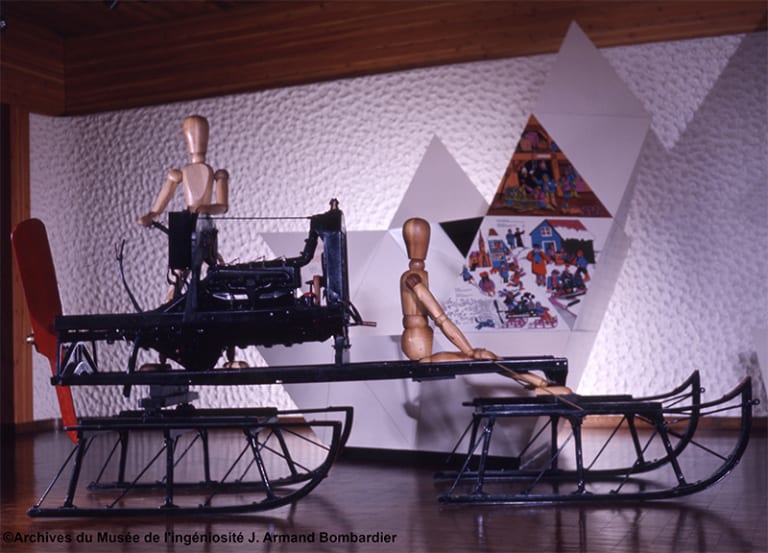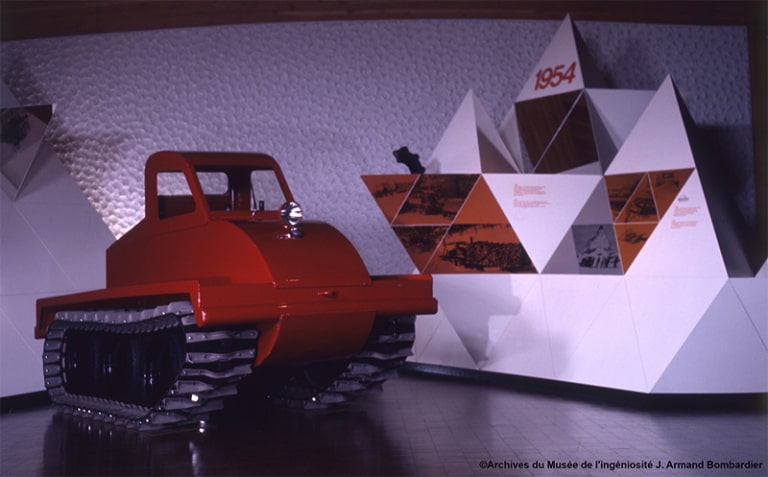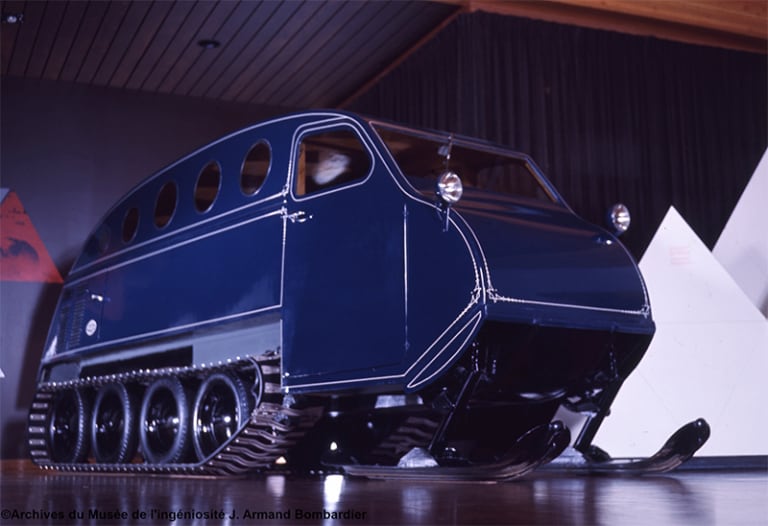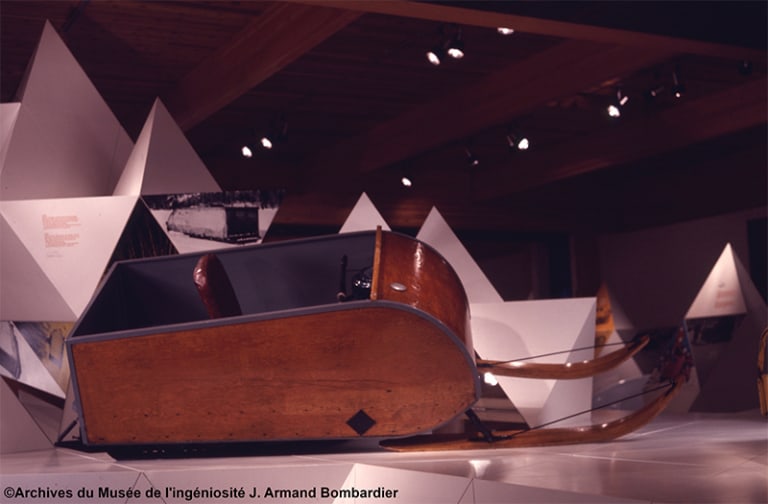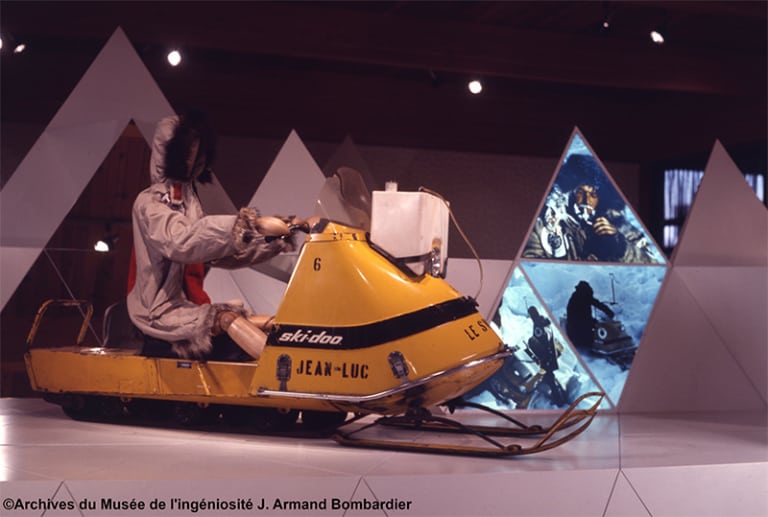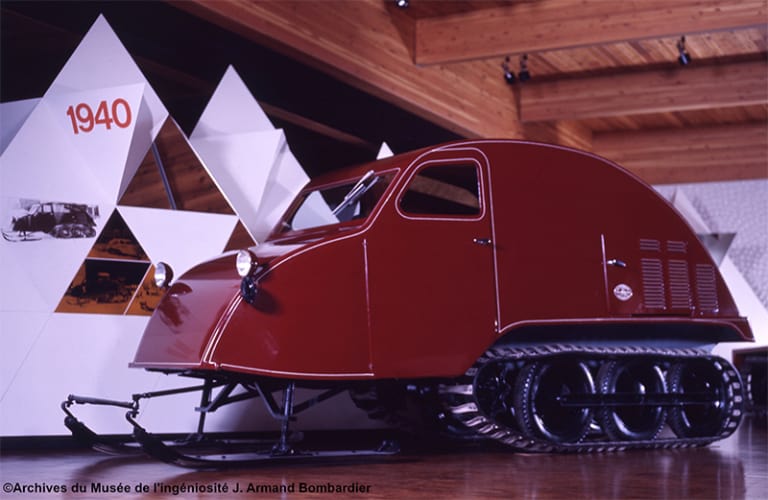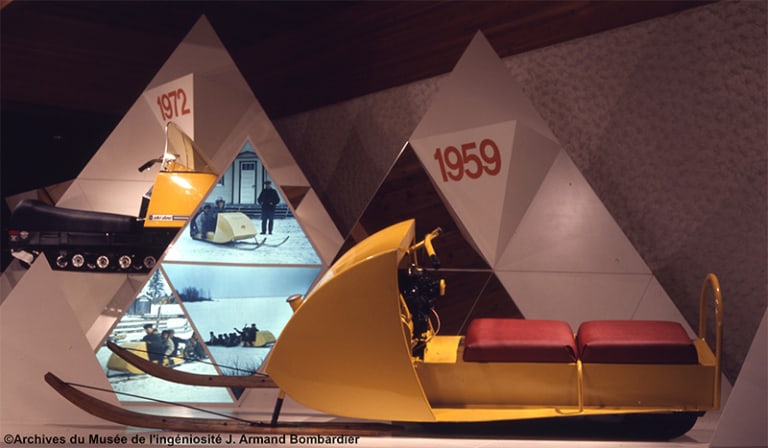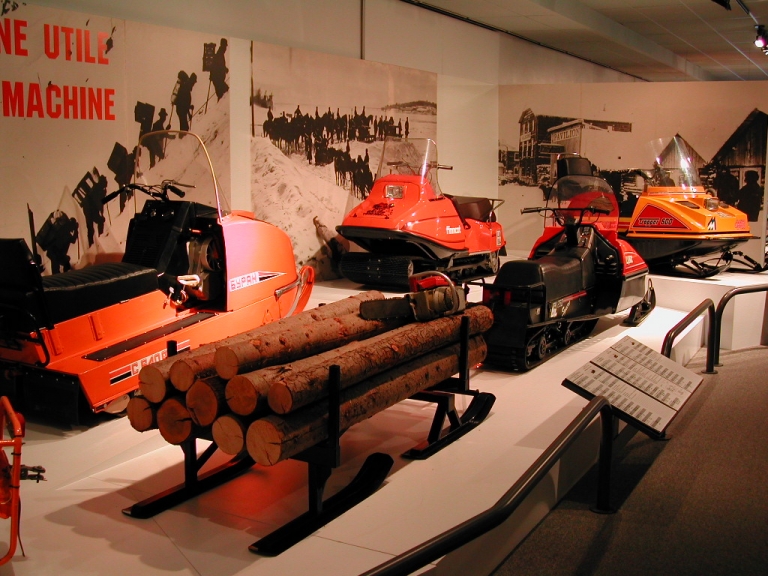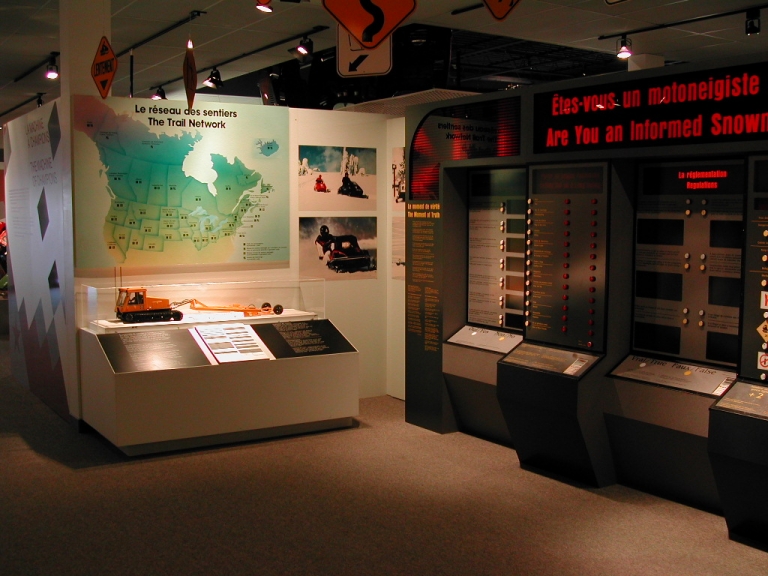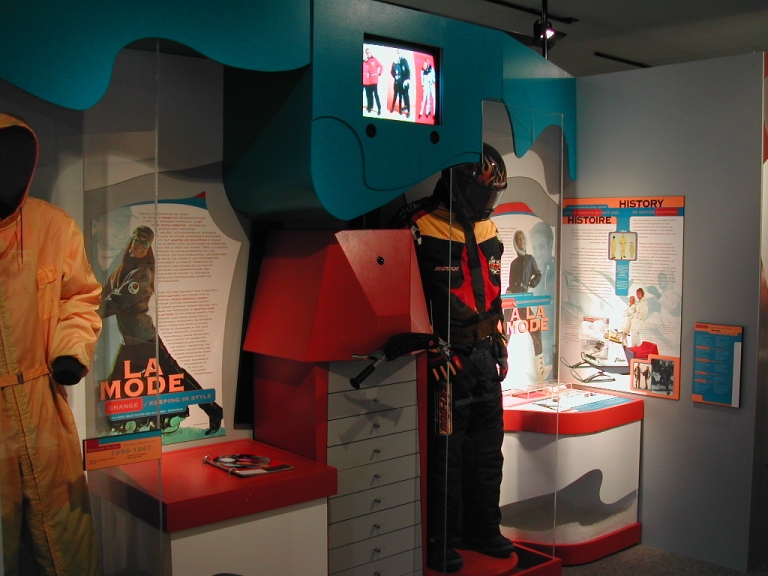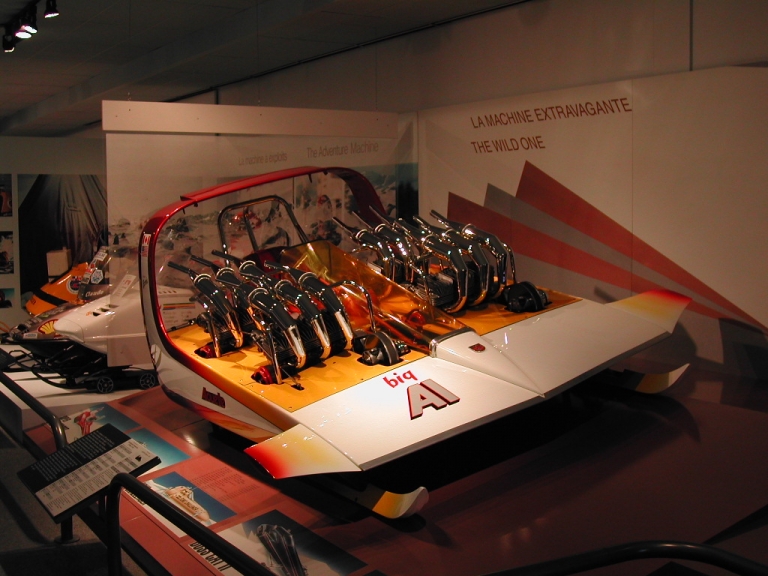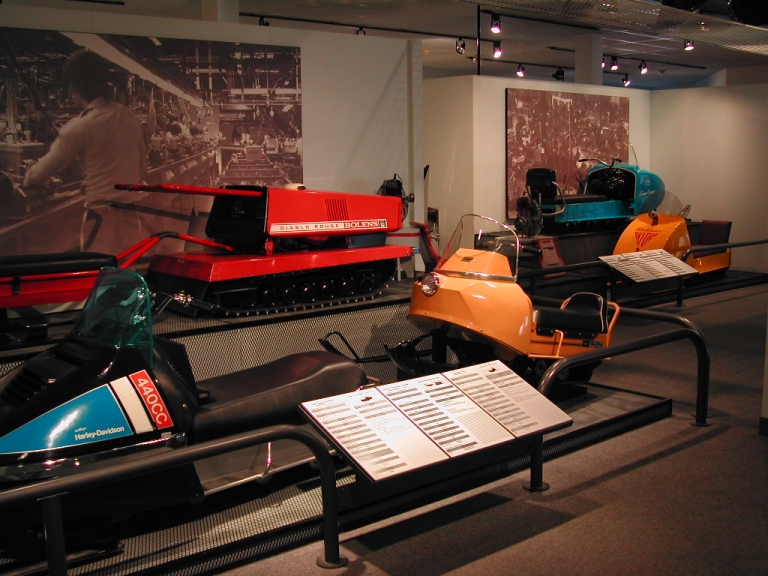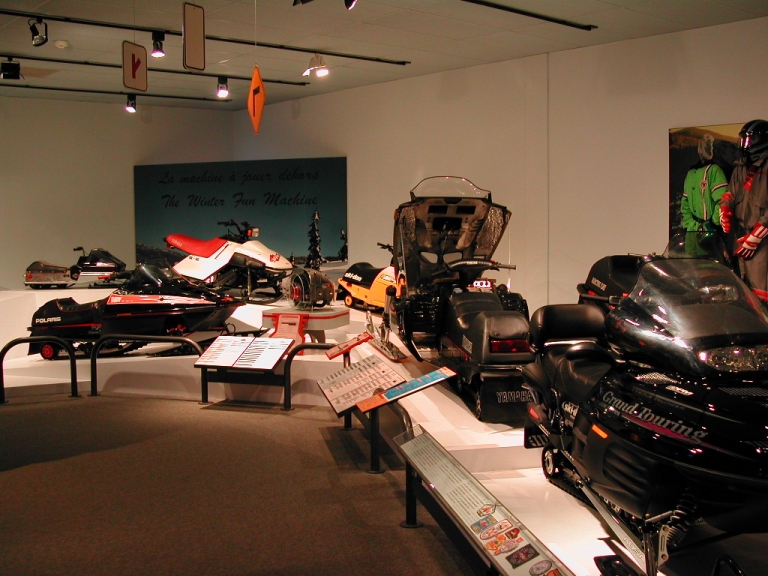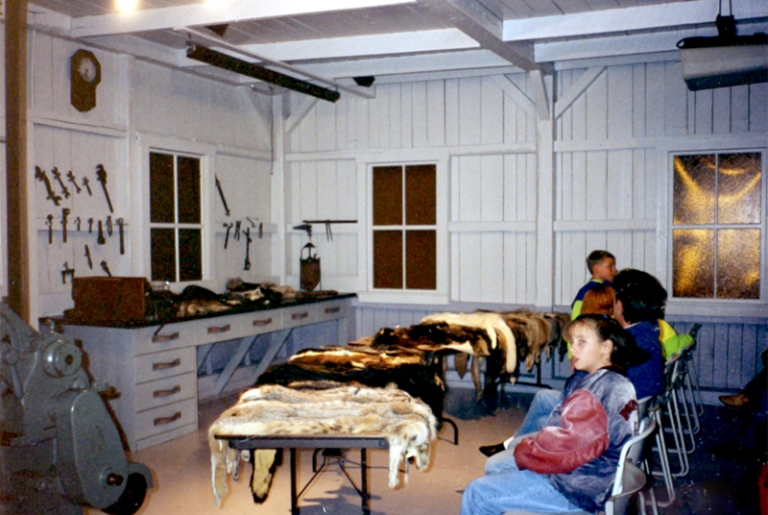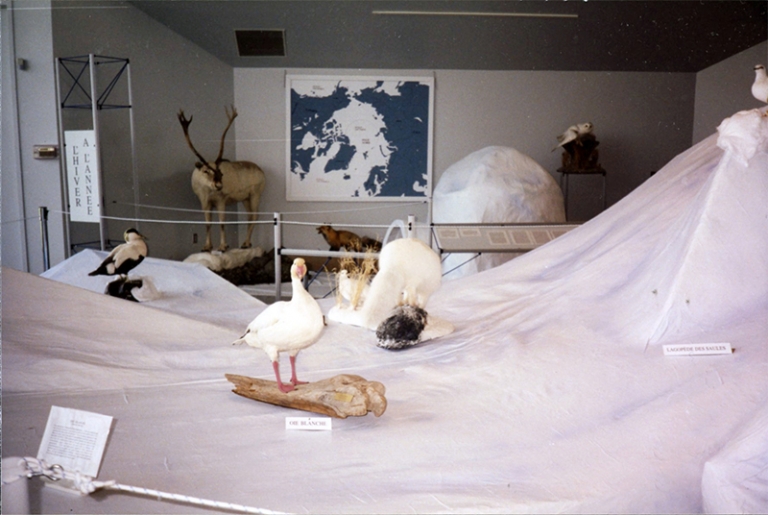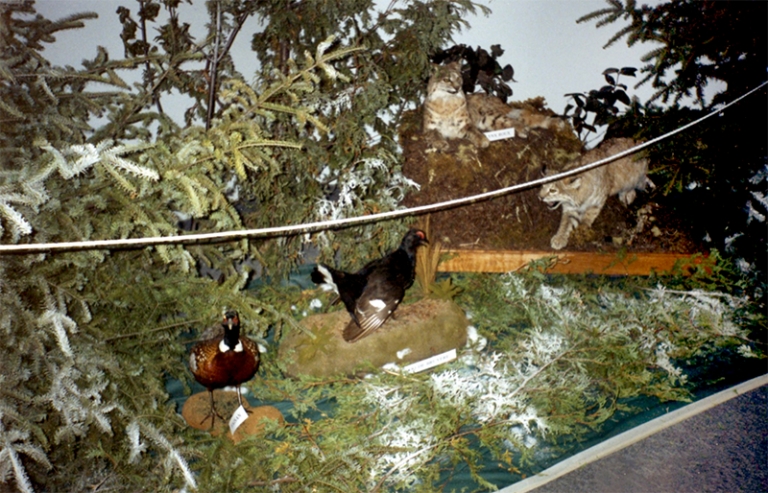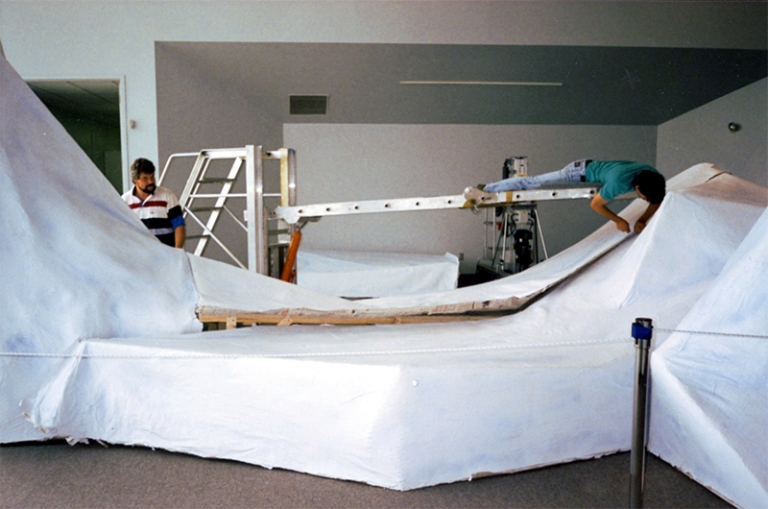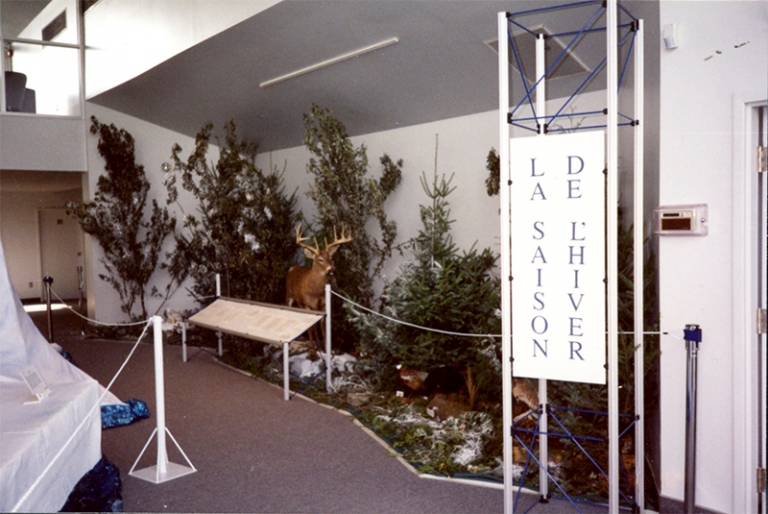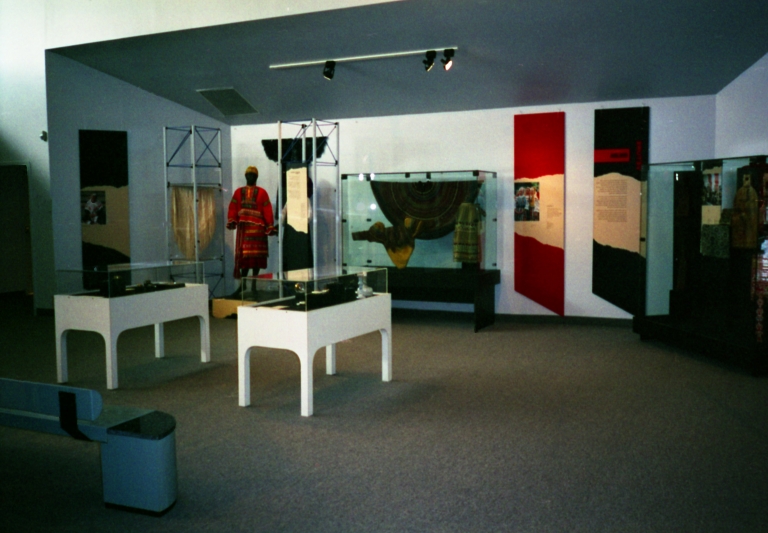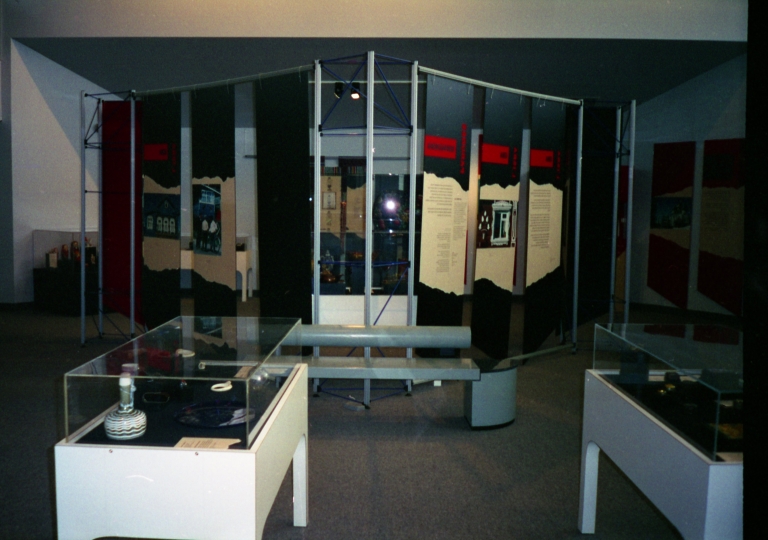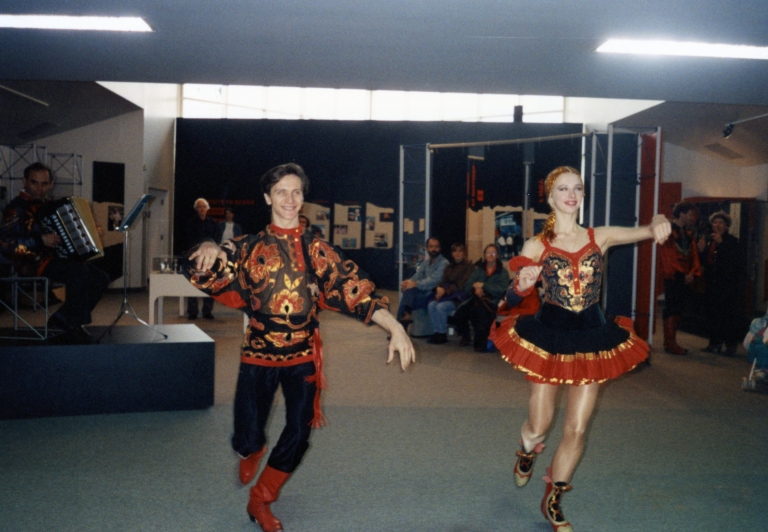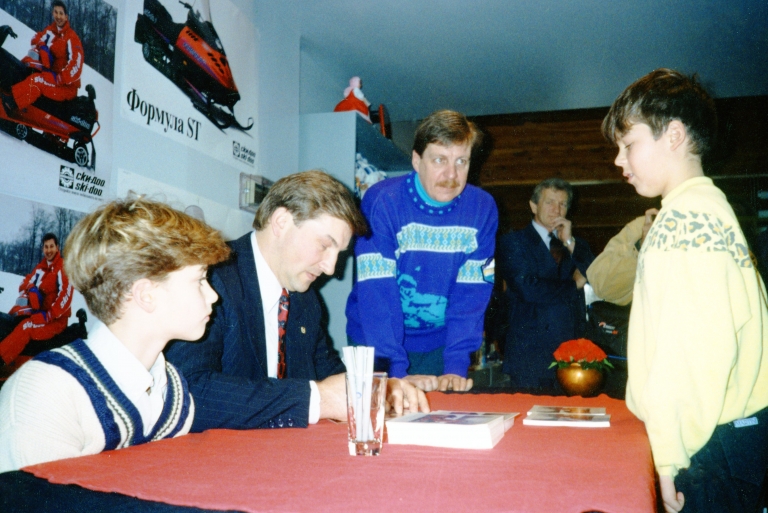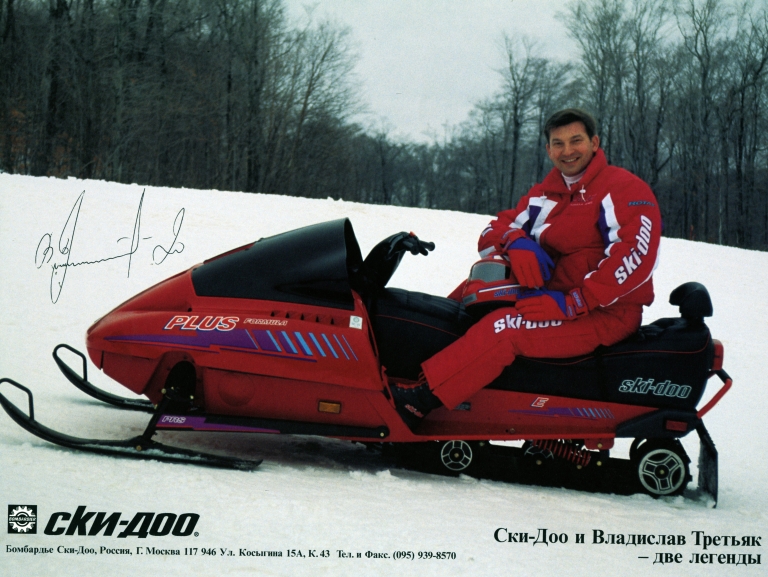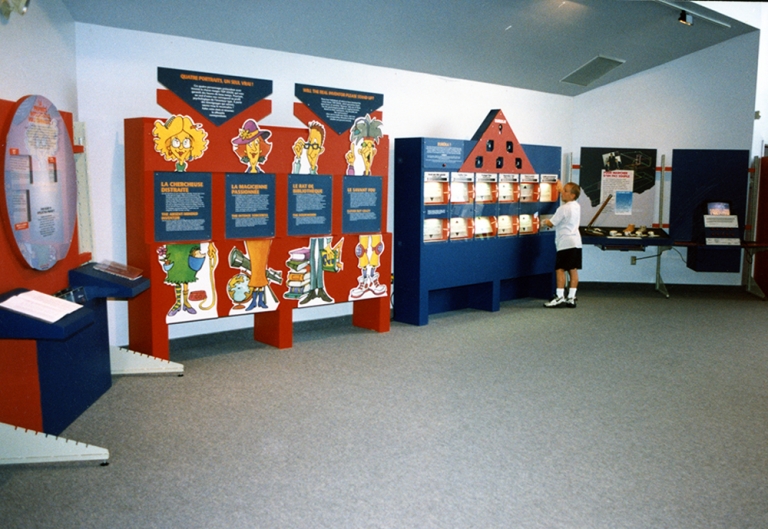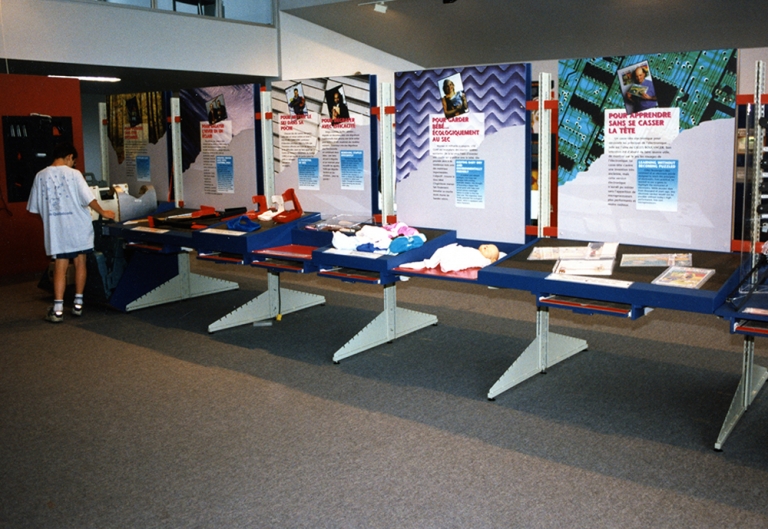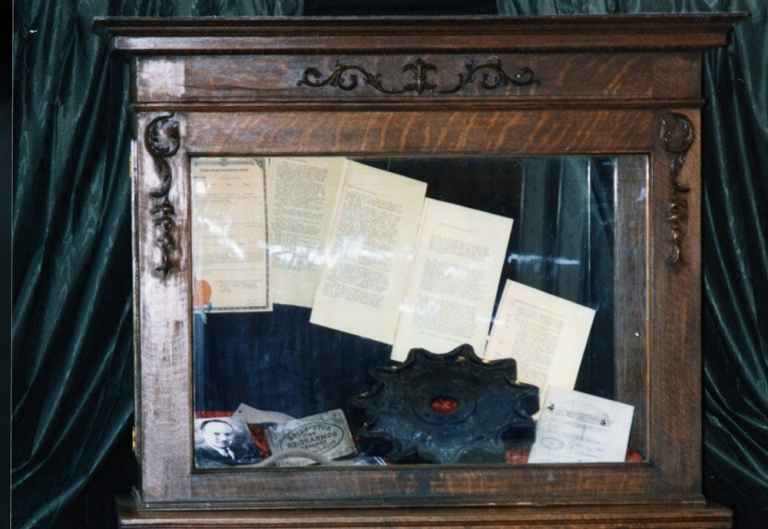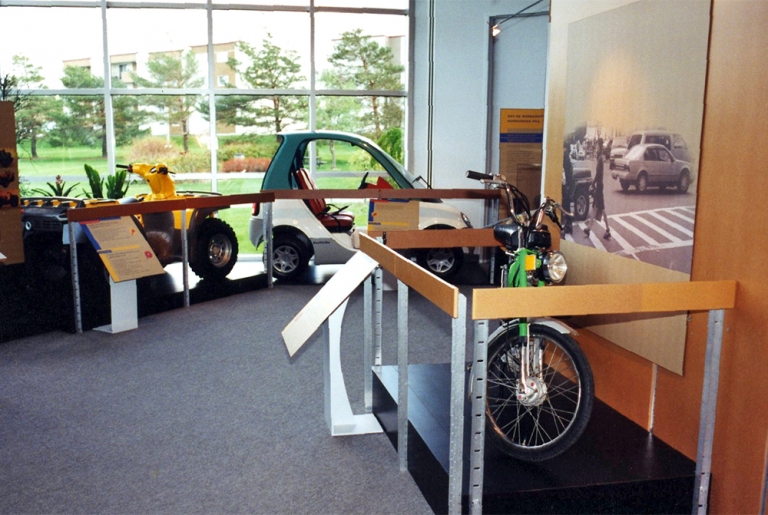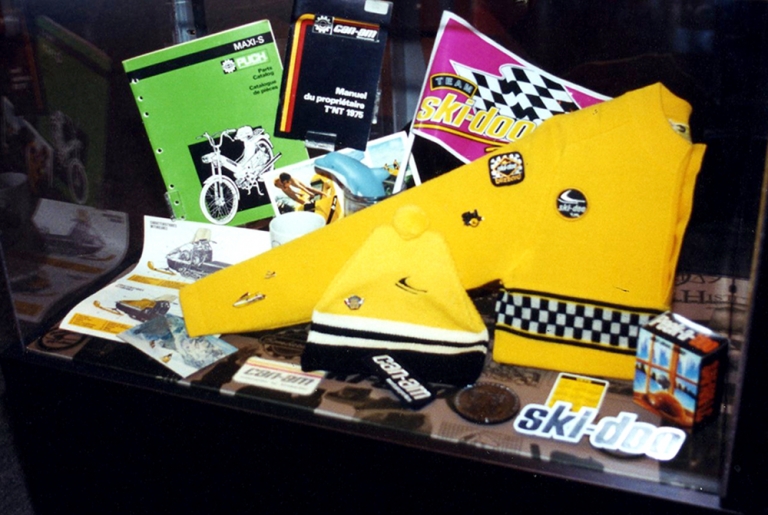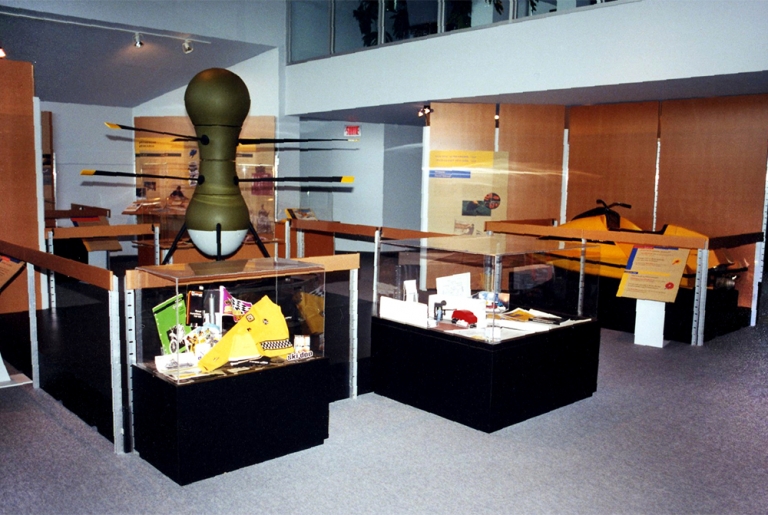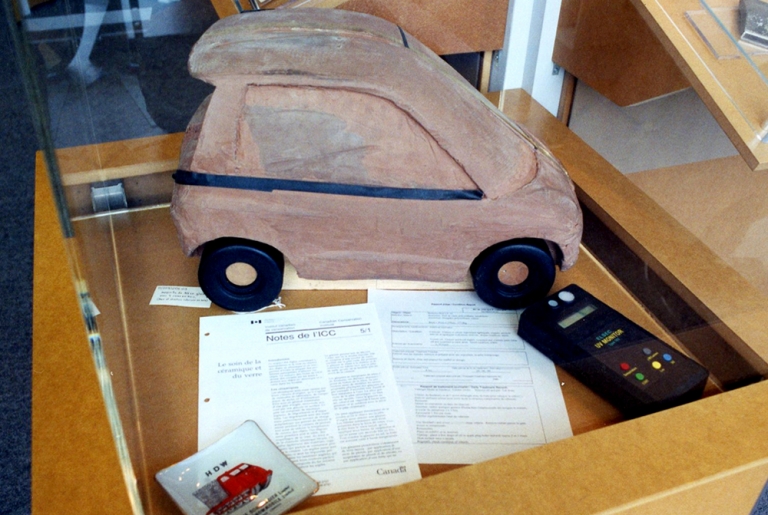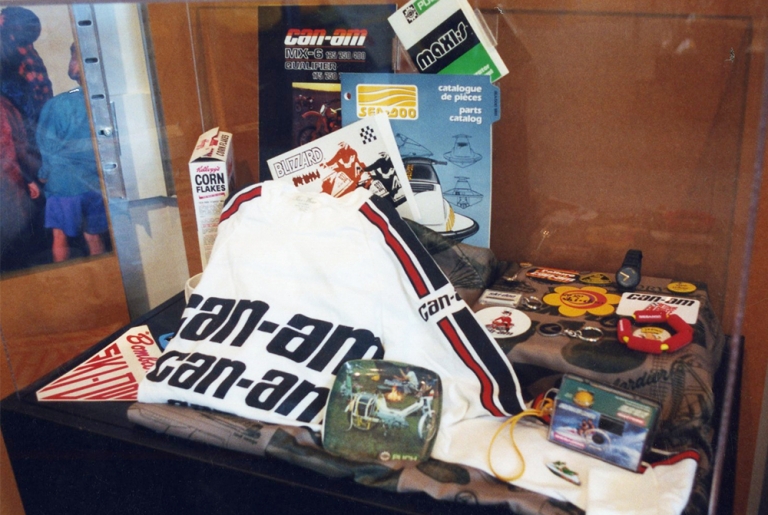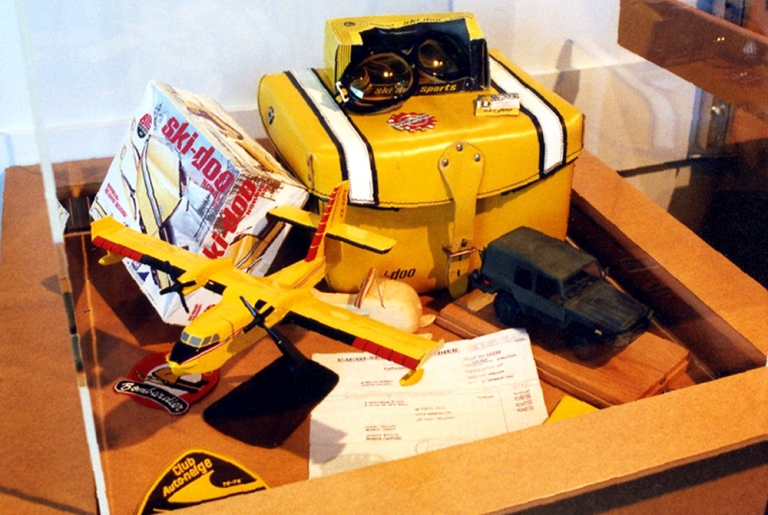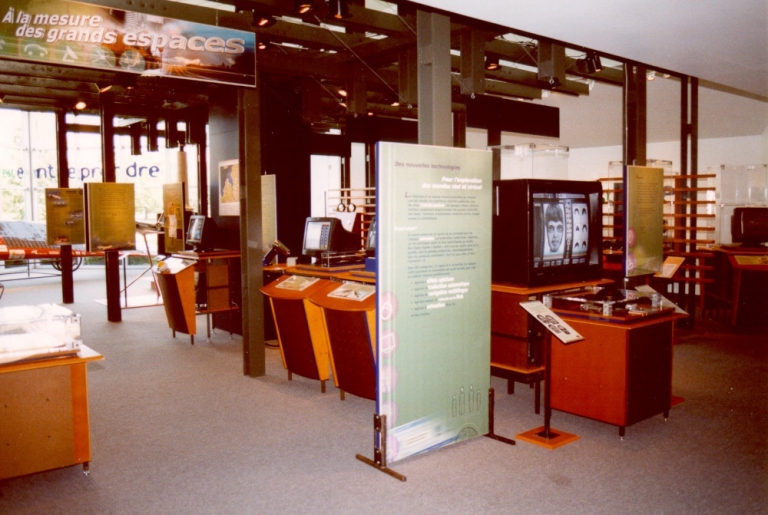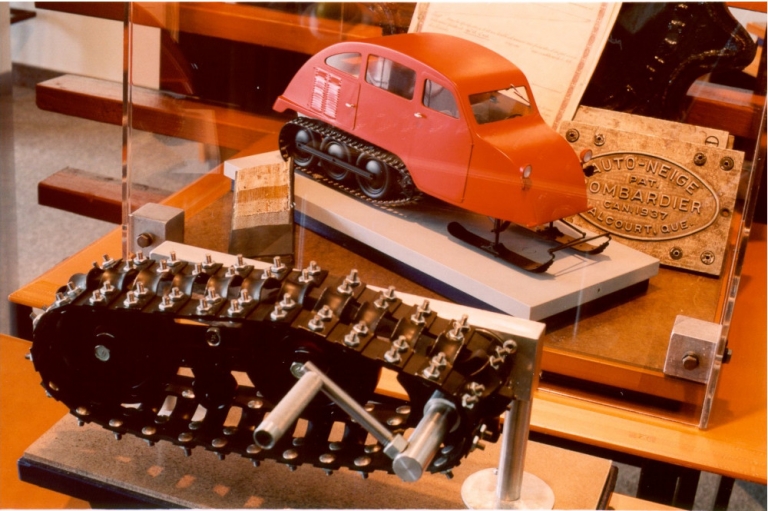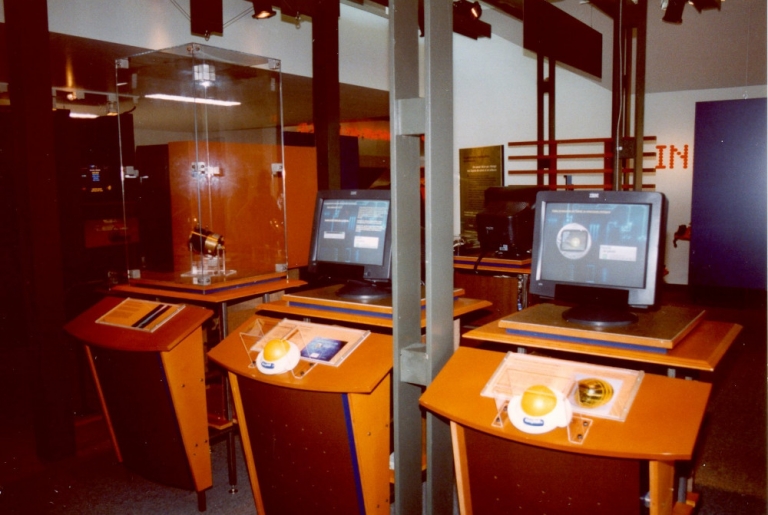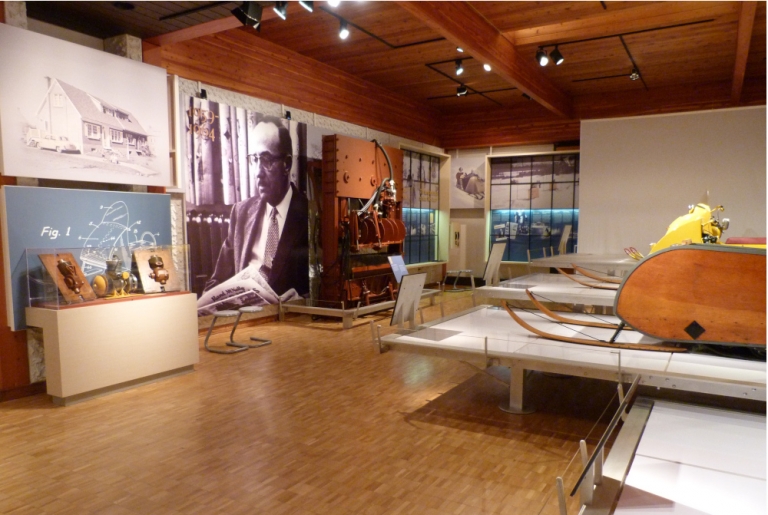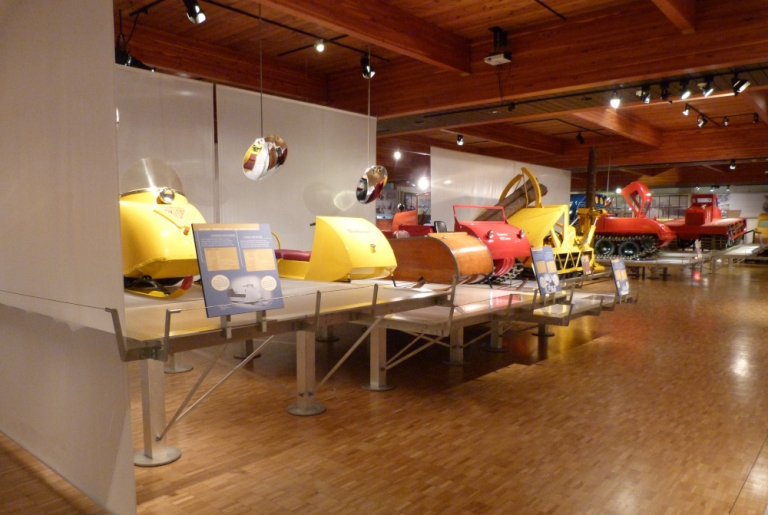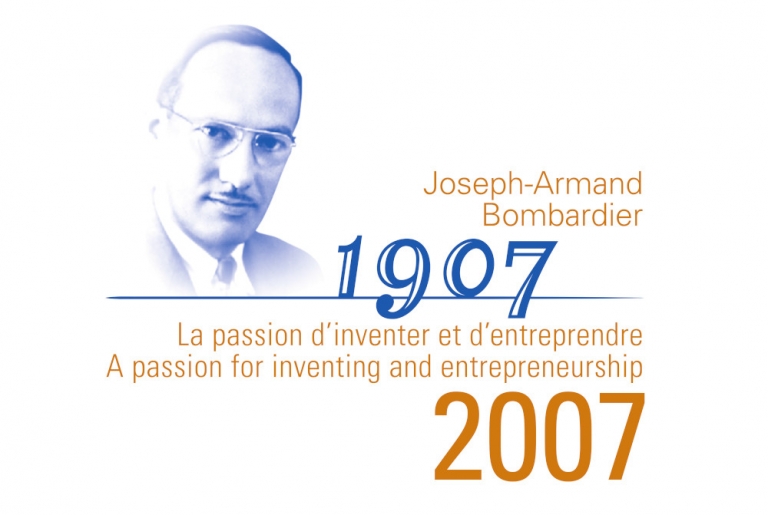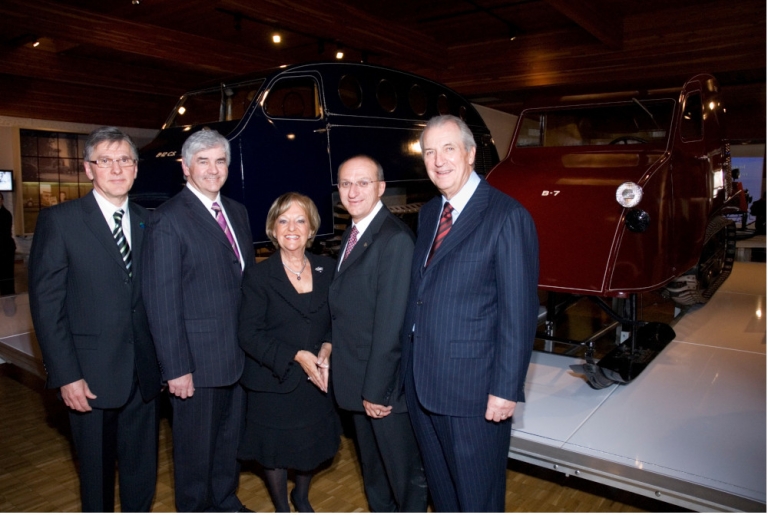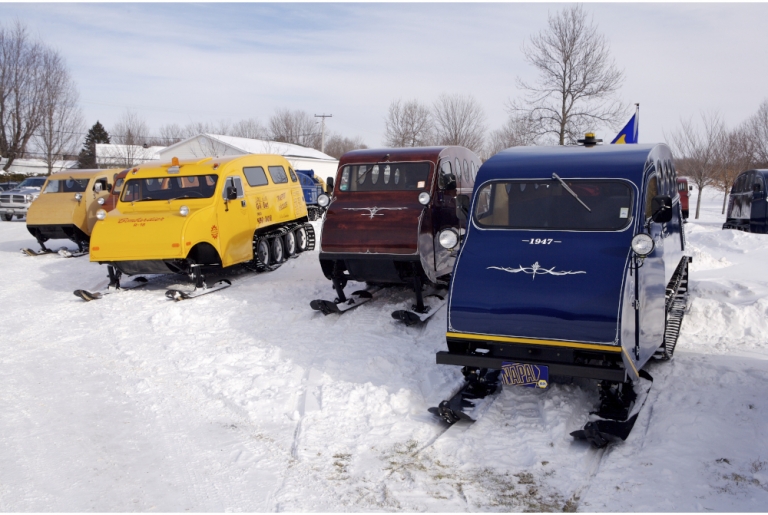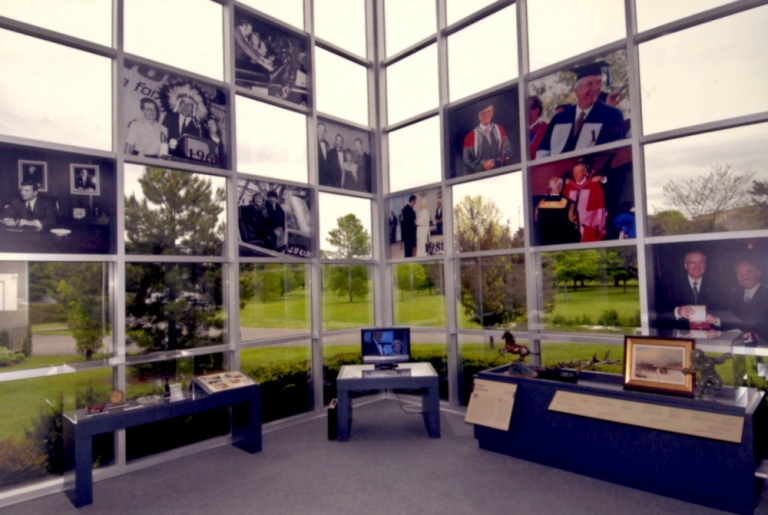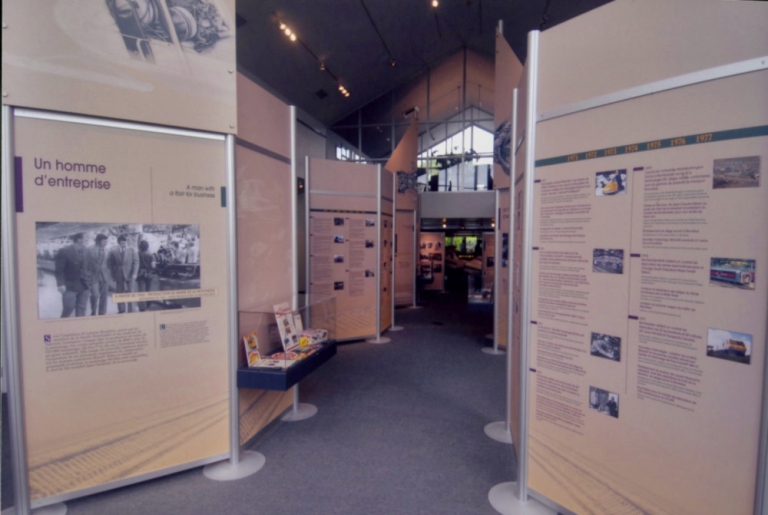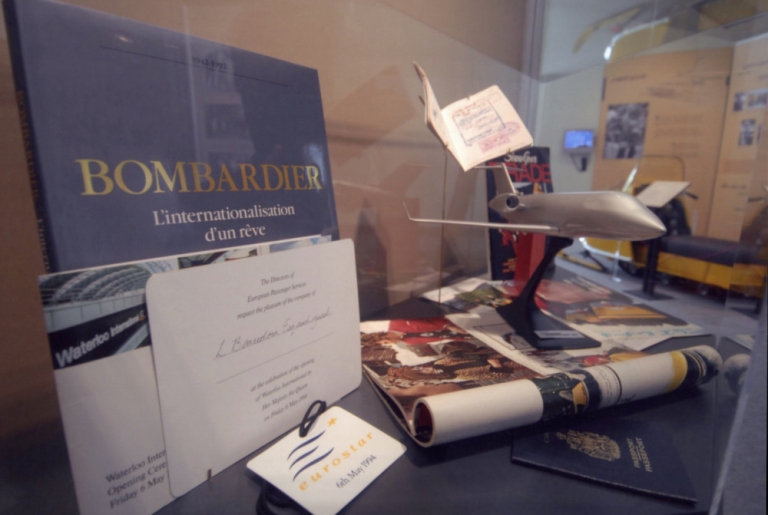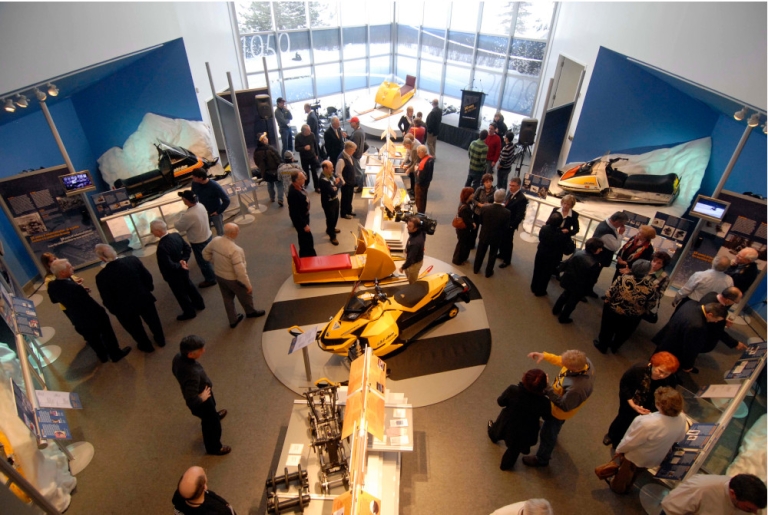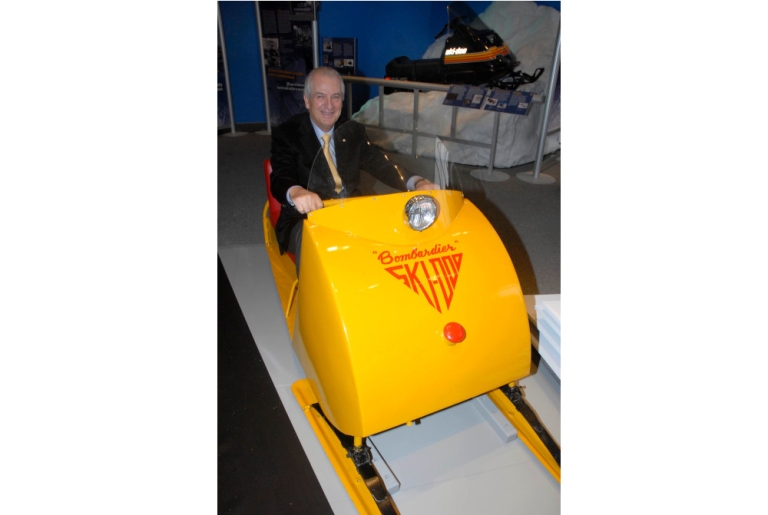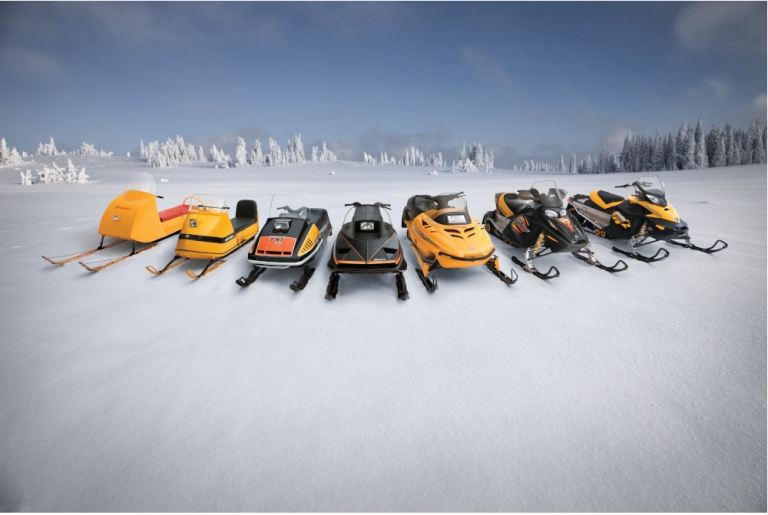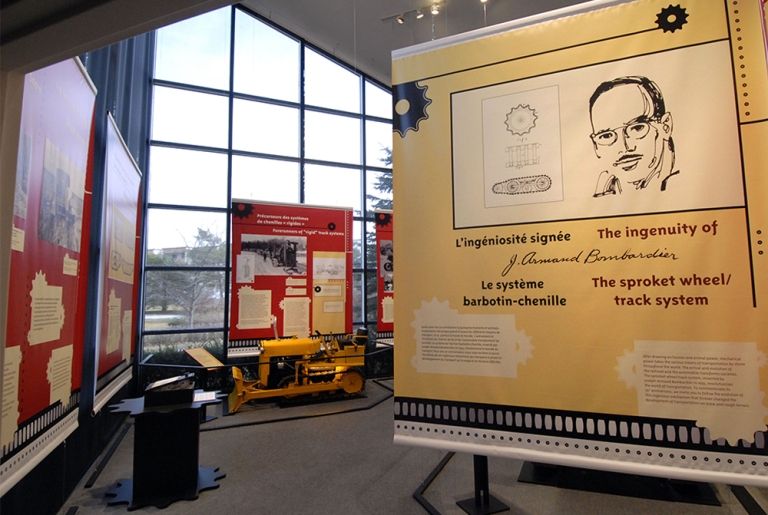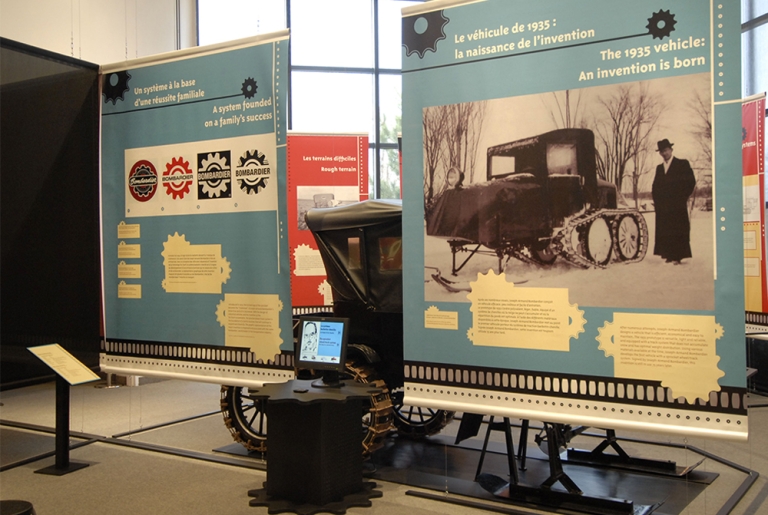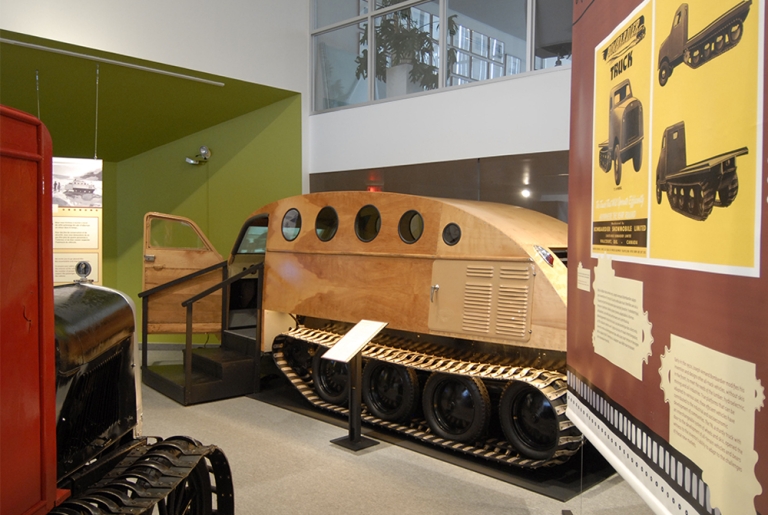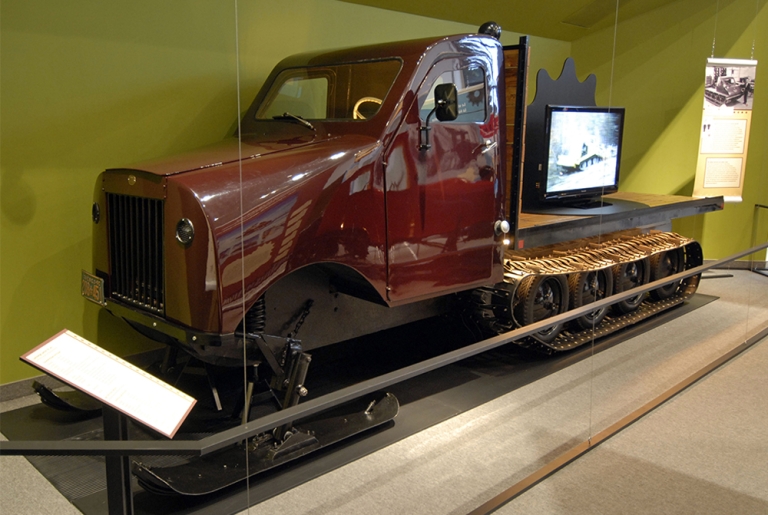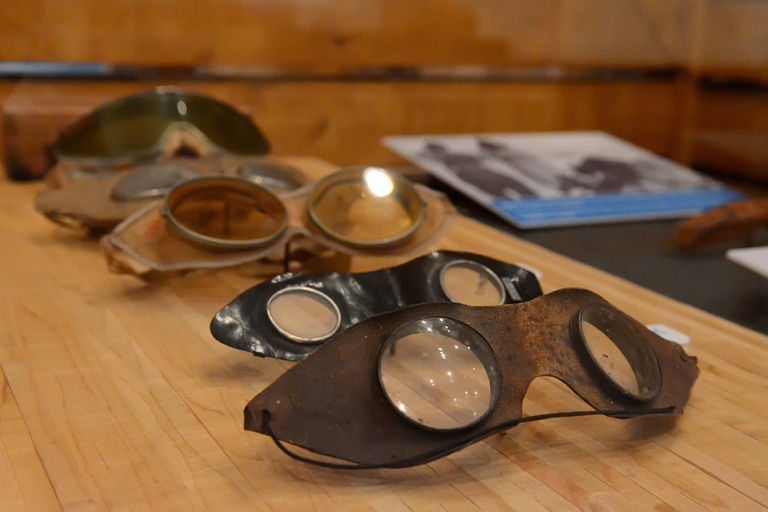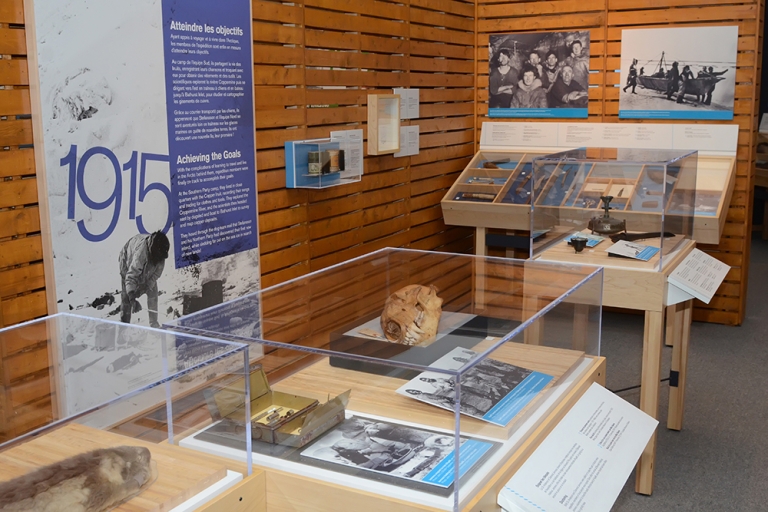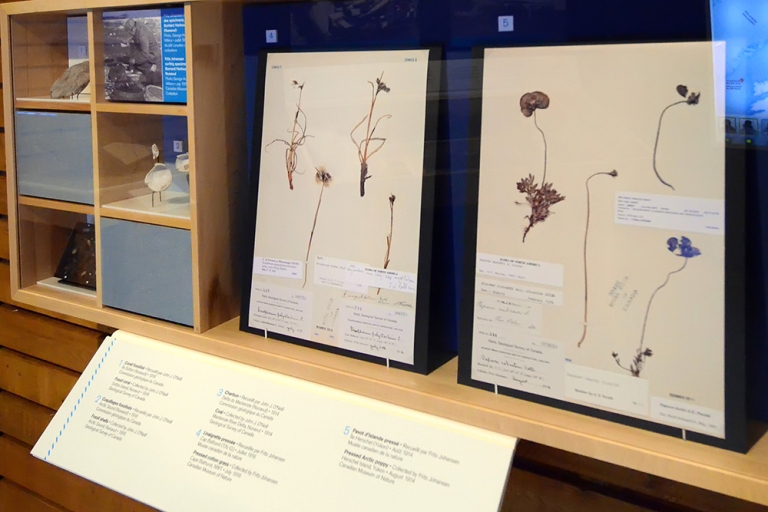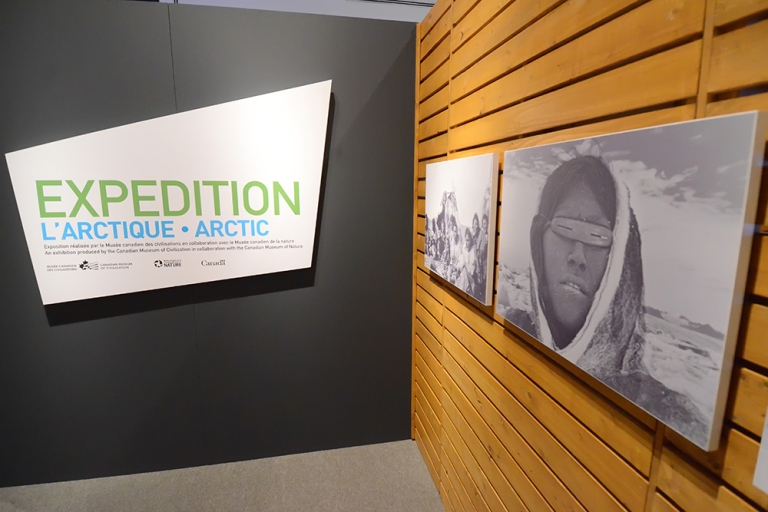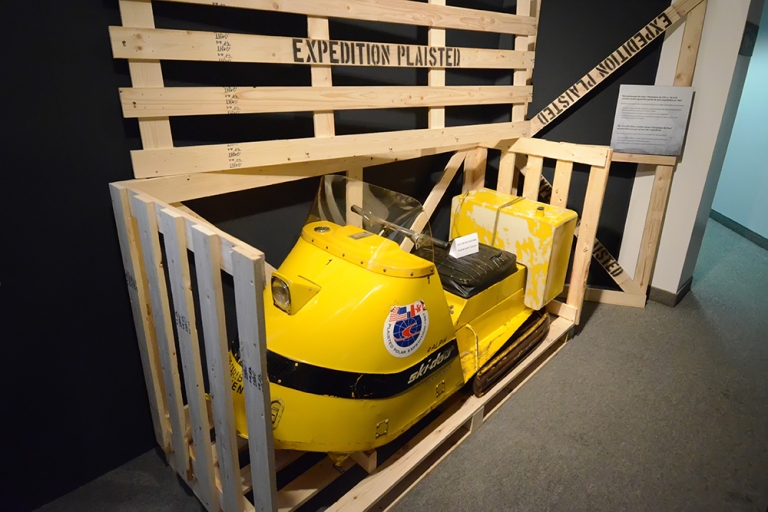50 years of history
This year the Museum is celebrating its 50th anniversary!
To celebrate the Museum’s 50th anniversary, our Collections team went through the archives with a fine-tooth comb and decided to shine the light on 12 exhibitions that have marked the institution over the years.
Since the Museum’s opening in 1971, more than 80 exhibitions have been admired in the public spaces and temporary and permanent exhibition rooms. As you can imagine, the team was faced with some difficult choices. Our writers selected materials based on their personal interests as well as the exhibitions they had helped to design or set up.
Each month, you’ll be able to revisit past exhibitions through a written account provided by one of our experts and posted here . Because 50 years of history is worth talking about. Enjoy discovering our past!
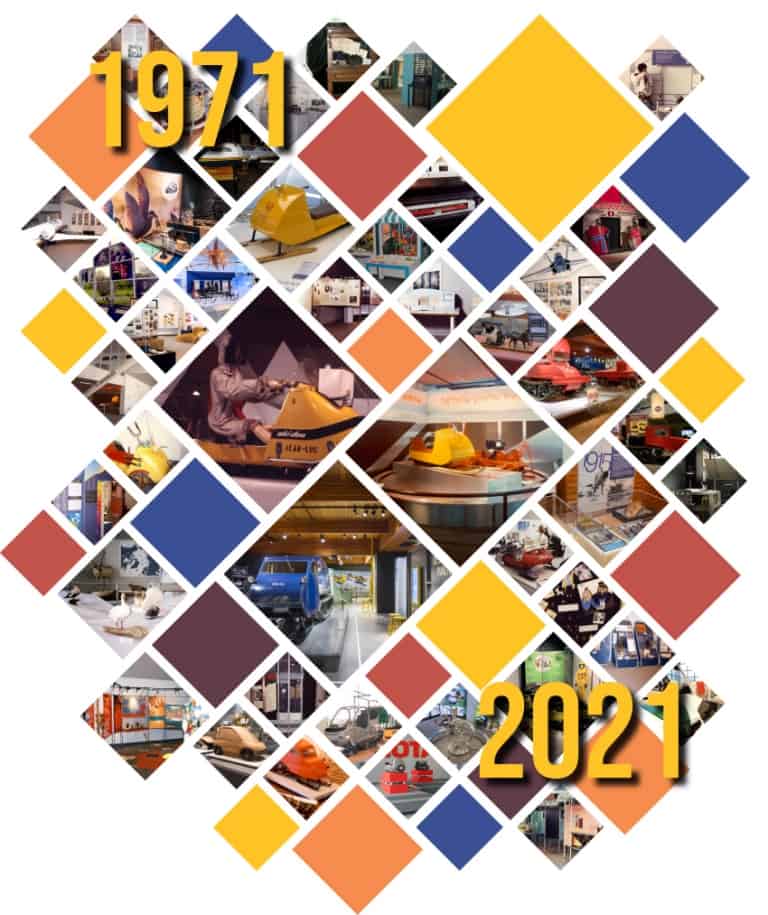
J. Armand Bombardier, an inventor
- September 11, 1971, to July 15, 1988
-
In 1968, Bombardier Inc. decided that it would no longer use the small building located near their first plant on St. Joseph Street, in Valcourt. The building in question was the Bombardier Garage.
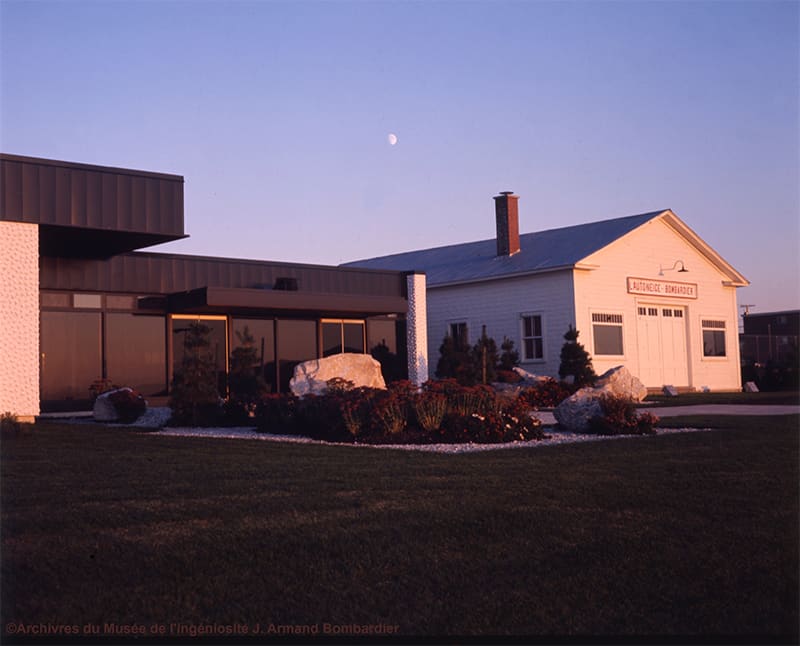
The J. Armand Bombardier Museum in Valcourt, circa 1971.
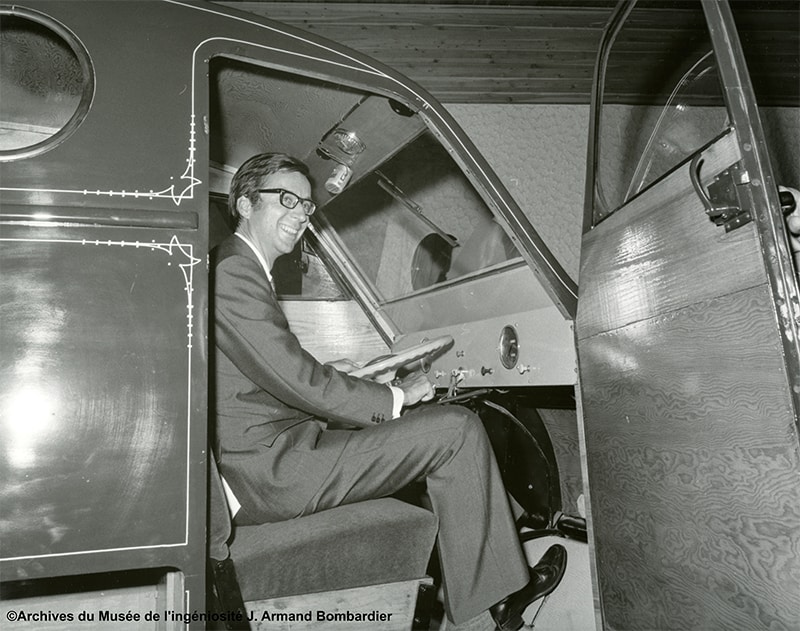
Robert Bourassa, Premier of Quebec, on board a B12 snowmobile at the inauguration of the J. Armand Bombardier Museum on September 11, 1971.
That same year, the J. Armand Bombardier Foundation acquired the building and moved it to a large plot of land in the heart of Valcourt, with a clear goal in mind: to build a Museum that would pay tribute to one of Quebec’s greatest entrepreneurs.
The Museum took shape in large part thanks to the inventor’s family. Joseph-Armand’s brothers, Alphonse-Raymond, Léopold (deceased at the time of the opening) and Gérard, were appointed in 1968 to submit a project proposal for the creation of the Museum. Alphonse-Raymond got involved in developing the exhibition, designing the tour, gathering testimonials, and much more. He even re-created old sketches lost by Joseph-Armand for the exhibition. Alphonse-Raymond was the first Director of the Museum, a position he held until 1983. Léopold and Gérard took on the challenge of selecting and restoring the vehicles for the exhibition.
A brand new building was constructed and annexed to the small, red and white garage, and on September 11, 1971, the J. Armand Bombardier Museum was finally inaugurated, presided over by Quebec Premier Robert Bourassa. The event was attended by a number of provincial and federal members of parliament, who came to pay tribute to Joseph-Armand Bombardier.
The Museum’s eagerly awaited permanent exhibition gave visitors a tour of Joseph‑Armand Bombardier’s endeavours in chronological order, showcasing the inventor’s vehicles, including his very first 1922 prototype, his “Autoneiges” passenger snowmobiles, the Muskeg tractor, and his famous Ski-Doo® snowmobile, released on the market in 1959.
The exhibition decor was inspired by winter landscapes. Each vehicle was nestled among white-capped mountains, embellished with images, mirrors and the vehicles’ market launch dates.But the Museum’s truly unique feature remained the small garage where it all started—the original workspace where Joseph-Armand Bombardier forever changed snow transportation and conquered winter.
The International Snowmobile Exhibition
- March 24, 1990 to February 23, 2015
-
In 1988, renovations got underway to refresh and revitalize the Museum and the exhibition paying tribute to the life and work of inventor Joseph‑Armand Bombardier. The building’s surface area increased to twice its former size, and included a second, permanent exhibition room for the International Snowmobile Exhibition dedicated to the history of the much-loved snowmobile.
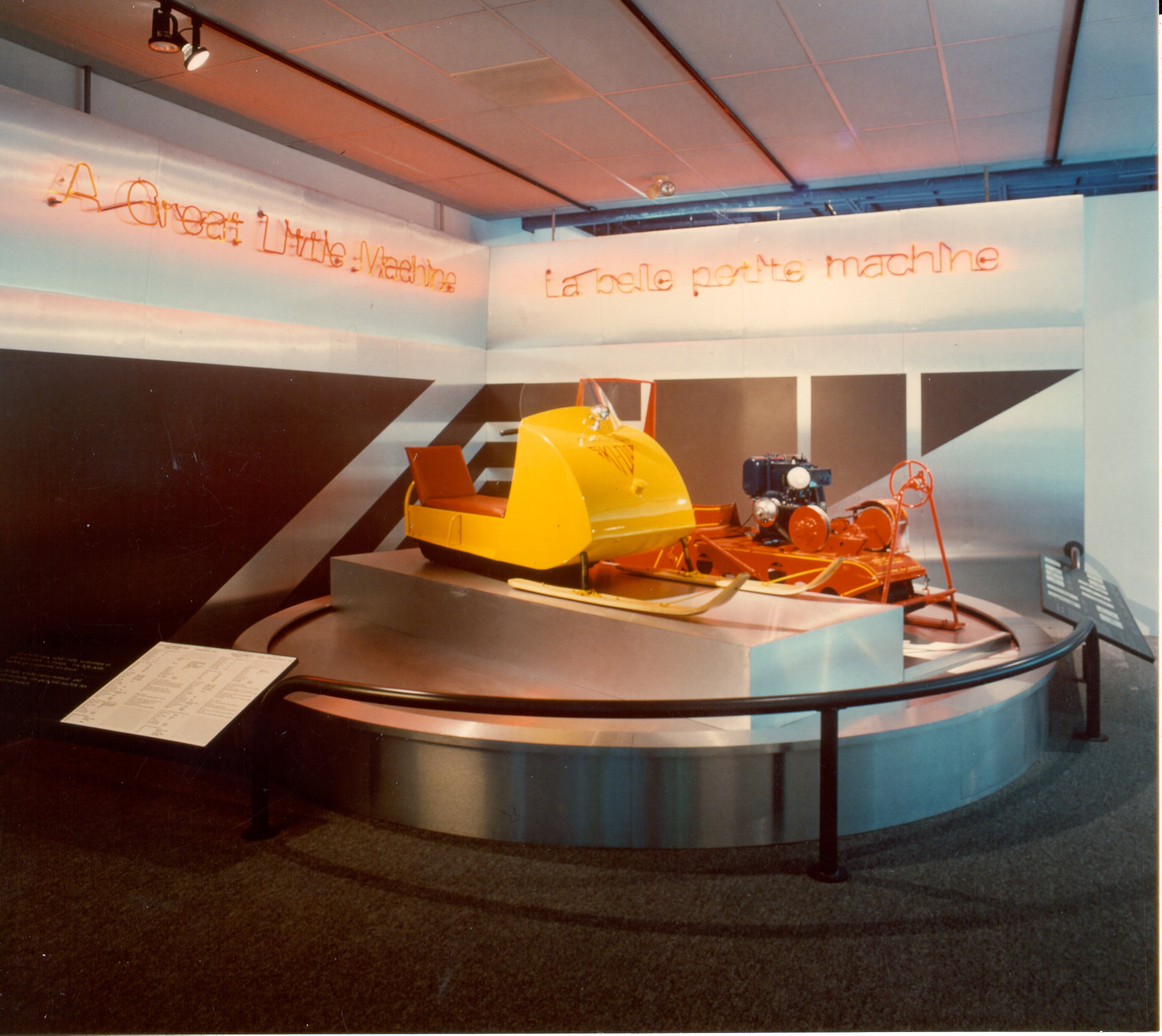
1960 Ski-Doo® K60 and 1962 Polaris Sno-Traveler, permanent exhibition, ˝International Snowmobile Exhibition˝, 1990.
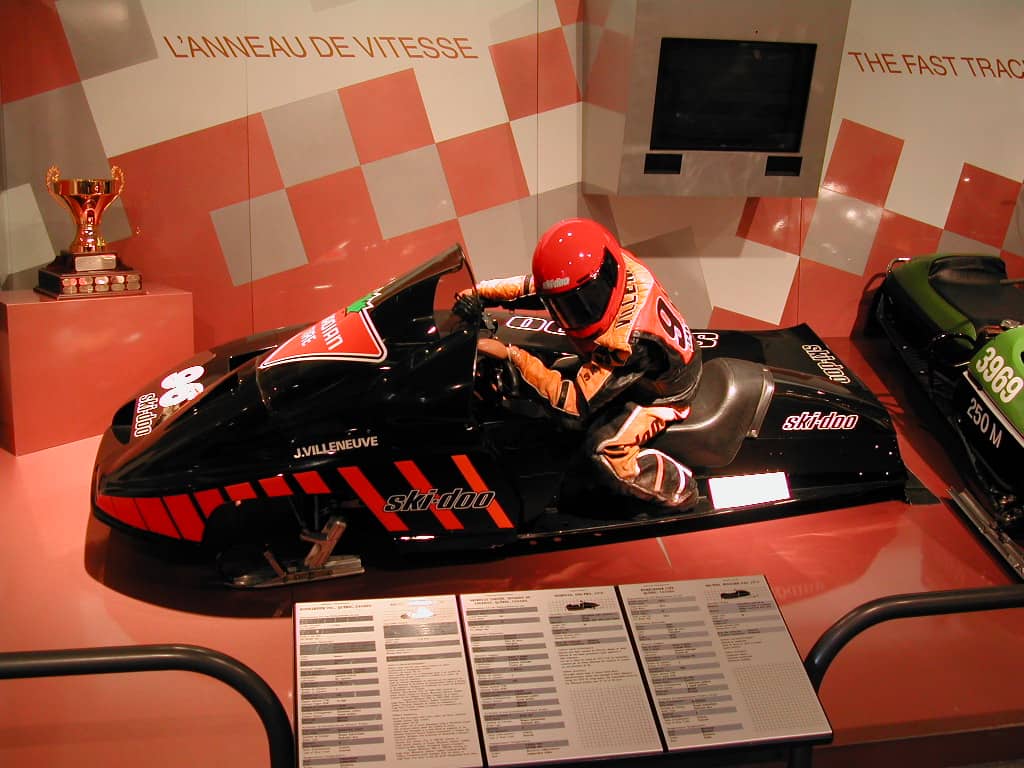
1985 Ski-Doo® Twin Track, permanent exhibition, ˝International Snowmobile Exhibition˝, 1990.
The March 23, 1990 inauguration felt like a déjà vu, with Robert Bourassa presiding over the opening ceremony just as he had at the Museum’s 1971 inauguration. This time, negotiations for the Meech Lake Accord provided a backdrop for the event. The premier ended up holding a press briefing to answer questions from journalists who had travelled to Valcourt from Toronto and Montreal for a statement on the Accord. The Museum team, which was not expecting press coverage of the sort, was mentioned in a number of articles on the Meech Lake Accord, following the press briefing.
The International Snowmobile Exhibition was designed around six thematic zones, each one representing a facet of the snowmobile industry. The theme “The Great Little Machine” tells of the advent of the snowmobile; “The Machine of Plenty” sheds light on the industry ins and outs; “The Sewing Machine” spotlights snowmobile fashion; “The Winter Fun Machine” explores outdoor recreation; “The Useful Machine” outlines the utilitarian aspects; and “The Machine of Champions” showcases impressive feats, races and records. Vivid colours, metallic surfaces and geometrical shapes provided a lively decor for showcasing the world of snowmobiling.
While an exhibition design may need refreshing from time to time, the history of Joseph‑Armand Bombardier is timeless. As Robert Bourassa so aptly put it at the Museum’s opening ceremony, “Joseph‑Armand Bombardier is one of the pioneers who paved the way for Quebec’s economic expansion, and his memory as a role model for entrepreneurship deserves to be kept alive for future generations.”
Les animaux des pays de l’hiver
- September 21 to November 15, 1992
-
In the early 1990s, visitors began to flock to the J. Armand Bombardier Museum. This rush of enthusiasm was due in part to the Museum’s 1990 relaunch with the new, permanent exhibit, The International Snowmobile Exhibition, followed by the Bombardier mini-series, which aired in February 1992. This was the backdrop for the Museum team as they designed the temporary exhibition Les animaux des pays de l’hiver.
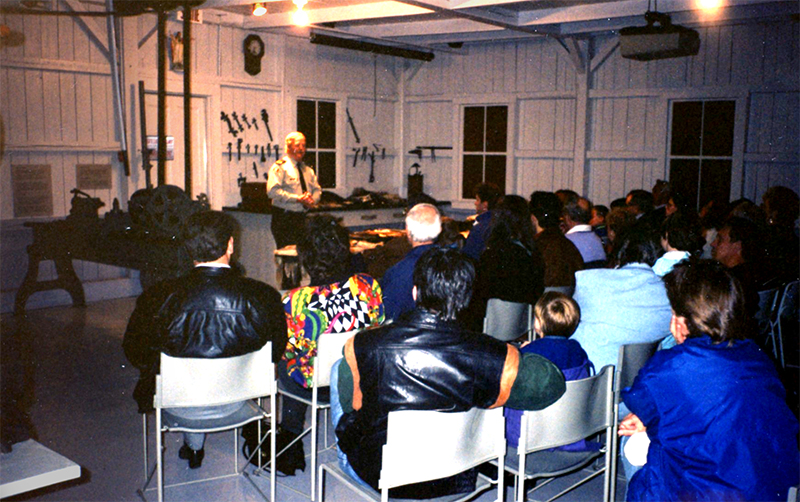
Presentation facilitated by Laurent Cloutier from the ministère du Loisir, de la Chasse et de la Pêche, Quinzaines des Sciences science event, 1992.
The exhibition, created in collaboration with the Jean-Louis L’Écuyer Wildlife Museum, the Ministère du Loisir, de la Chasse et de la Pêche, and the Centre universitaire canadien de recherches internationales, featured stuffed and lifelike animals in their winter habitats. The Museum team used papier mâché to build different dioramas for displaying the animals. An ice floe, a forest and an igloo provided a stage for various animals, including the snow goose, the willow ptarmigan, the Arctic fox, the eider duck and the polar bear.
The exhibition’s educational component was bolstered by a presentation given on October 25 as part of the “Quinzaine des Sciences” science event. Laurent Cloutier from the ministère du Loisir, de la Chasse et de la Pêche led the presentation, using an impressive collection of animal pelts from northern habitats to explain the phenomenon of animal adaptations to winter. An audience of all ages showed up, and there was standing room only in the original Joseph-Armand Bombardier Garage, where the activity was held.
The Museum’s popularity continued to thrive throughout 1992, and on October 2nd, the institution welcomed its 300,000th visitor! Les animaux des pays de l’hiver was a hit with museum-goers and served as a stepping stone to more temporary exhibitions. It was the start of a new chapter for the Museum!
Visite en Russie
- October 12 to December 12, 1993
-
The year 1993 stands out in the history of the J. Armand Bombardier Museum for the sheer number of temporary exhibitions presented. That year, the Museum staged no fewer than seven exhibits in the exhibition hall, setting a record!
Among those exhibitions was the Visite en Russie. It was designed by the Musée de Charlevoix in collaboration with the All-Russian Decorative Art Museum in Moscow, and ran from October 12 to December 12, 1993.

The “Visite en Russie” on display in the exhibition hall, 1993.
Exhibition-goers were taken to the heart of Russia via a collection of 80 objects representing Russian folklore, traditions, legends and daily life in the vast country. While the “Visite en Russie” was on display, the Museum boutique sold a variety of Russian souvenirs, including wooden toys and Matryoshka dolls, also known as Russian nesting dolls.
While hosting the exhibition, the Museum held a very special event. On November 14, 1993, the team brought Vladislav Tretiak, legendary hockey goaltender for the Soviet Union and well-known for his outstanding performance at the Summit Series in 1972, and a group of professional Russian dancers, to the Museum. Their presence really brought the programming to life.
A combination of circumstances made the event possible. In February 1993, Bombardier Inc. appointed Vladislav Tretiak as official spokesperson for Ski-Doo® snowmobiles in Russia. As luck had it, he happened to be in Valcourt just at the right time. The Russian dancers, who were on tour in Canada, were also available to join the Museum event. The dancers performed from noon to 4 p.m., accompanied by Peter Chodorovsky on the bayan, a Russian accordion. And from 2 p.m. to 4 p.m, Vladislav Tretiak met with fans and signed autographs.
To top it all off, the some 500 people who visited the Museum that day were greeted with bread and salt, in keeping with Russian tradition!
Fallait y penser : le génie créatif
- June 27 to November 2, 1997
-
First there is a need, and then, a solution. Those who find solutions help to move the world forward. These inventors build societies. Joseph-Armand Bombardier was one of them.
At the time, the villagers needed to travel over snow during the winter months, and Joseph-Armand Bombardier found a solution: the snowmobile. In 1935, he invented the sprocket wheel and track drive system—his first major invention for which he was granted a patent (June 29, 1937). The track system was used on the B7 snowmobile. And so it was only natural that the exhibition honouring the inventor’s creative genius and the 60th anniversary of his first patent was created under the theme “inventions.”
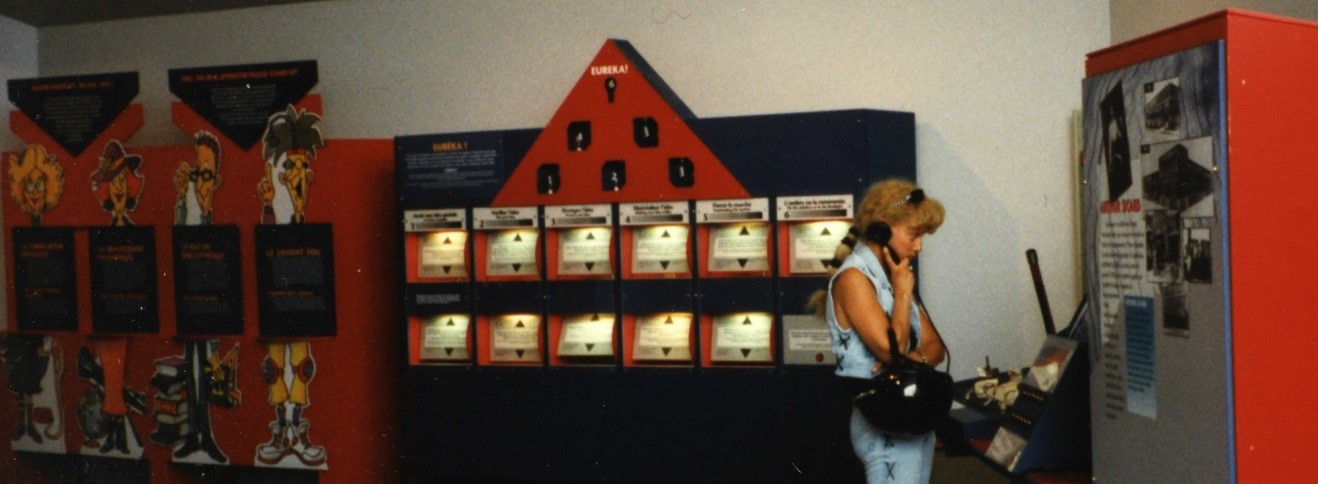
Interactive audio display on the inventors, at the exhibition « Fallait y penser. Le génie créatif : 60e anniversaire du premier brevet de Joseph-Armand Bombardier », 1997.
Designed by the Musée de la civilisation de Québec and presented by the J. Armand Bombardier Museum in Valcourt, the exhibition showcased inventions from 17 inventors, all from Québec. Families, school groups and “snow machine” enthusiasts came in droves. The exhibition ran for three months and attracted 16,867 visitors of all ages.
Information panels, a quiz and all kinds of inventions awaited Museum-goers. The itinerary included a host of interactive activities, such as “What’s it for?” and “Eureka!” which visitors enjoyed through telephones and objects mounted on the walls. Thirty prototypes were presented, including the cochlear implant (invented by François Duval and developed by Cosem Neurostim) and the eco-friendly, reusable diaper (invented by Lise Guay).
While the exhibition featured Joseph-Armand Bombardier, one of Québec’s most well-known inventors, it also shone the light on the immense talent in the province, including the new generation of innovators.
The Museum’s collection
- March 1 to September 17, 2000, and again from January 12 to March 2, 2001
-
Curious Museum-goers are always keen to catch a glimpse behind the scenes. This temporary exhibition showcased a variety of archived documents, objects and vehicles from the J. Armand Bombardier Museum Collection. It’s one of the only exhibitions to have gone on display twice in the history of the Museum.
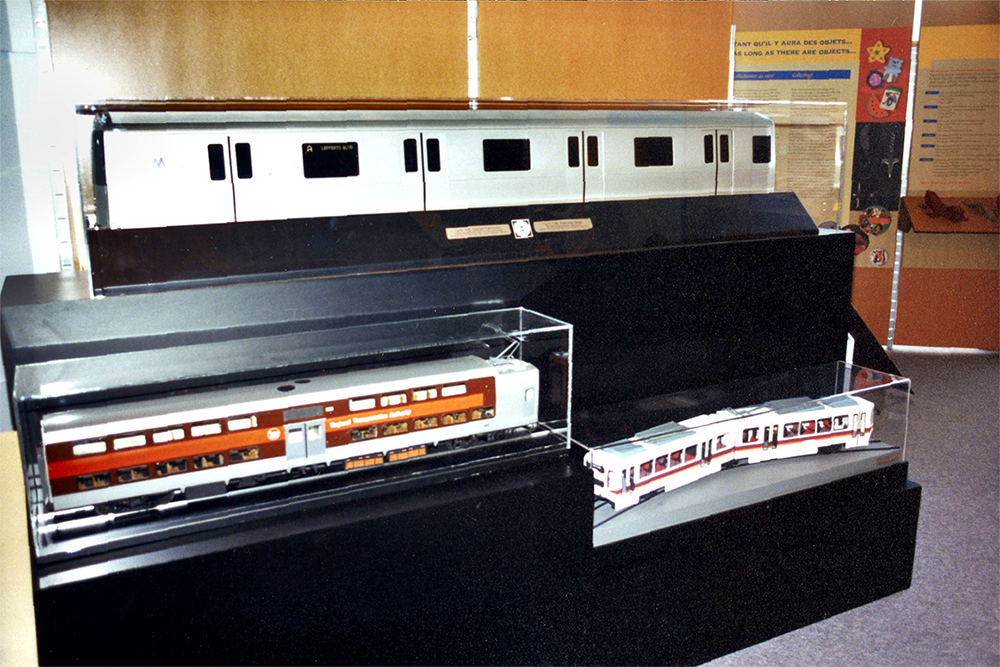
Scale models of the R110-B Subway car, the Chicago suburbs train and the Portland tramway, “The Museum’s collection … A world to discover!”, 2000.
The exhibition provided a unique view through the lens of museology, dividing the visit into thematic zones: research, acquisition, conservation, interpretation and collections. Sections titled “Take a closer look,” allowed visitors to learn more about specific elements of the collections from a technical viewpoint. Display cases featured a variety of archived documents and small objects from the Museum collections, including sales brochures, clothing and accessories, and promotional items.
The second showing of the exhibition was very similar to the first, except for a few changes of vehicles and models. The first exhibition featured the NEV, or Neighbourhood Electric Vehicle. Manufactured by Bombardier from 1997 to 1999, this small vehicle was designed for getting around the neighbourhood on a daily basis. The vehicle on display was extra special—it was Prototype no. 01, used to showcase the product to the public at trade shows.
A rare display of military products designed by Bombardier in the 1980s was also part of the exhibition. When The Museum’s collection … A world to discover! ran for the second time, it featured an Iltis all-terrain vehicle, along with a British military motorcycle.
Today, Museum-goers have year-long access to many of the remarkable objects in the reserve, thanks to the behind-the-scenes guided tour, Conquest through Innovation.
Le Québec technologique
- June 21, 2002 to February 2, 2003
-
Presented in Quebec City and Montreal in 2001, LE QUÉBEC TECHNOLOGIQUE Tout simplement génial! was launched the Ministère de la Recherche de la Science et de la Technologie du Québec (MFER), in collaboration with a number of public and private enterprises, and featured 80 technologically innovative products.
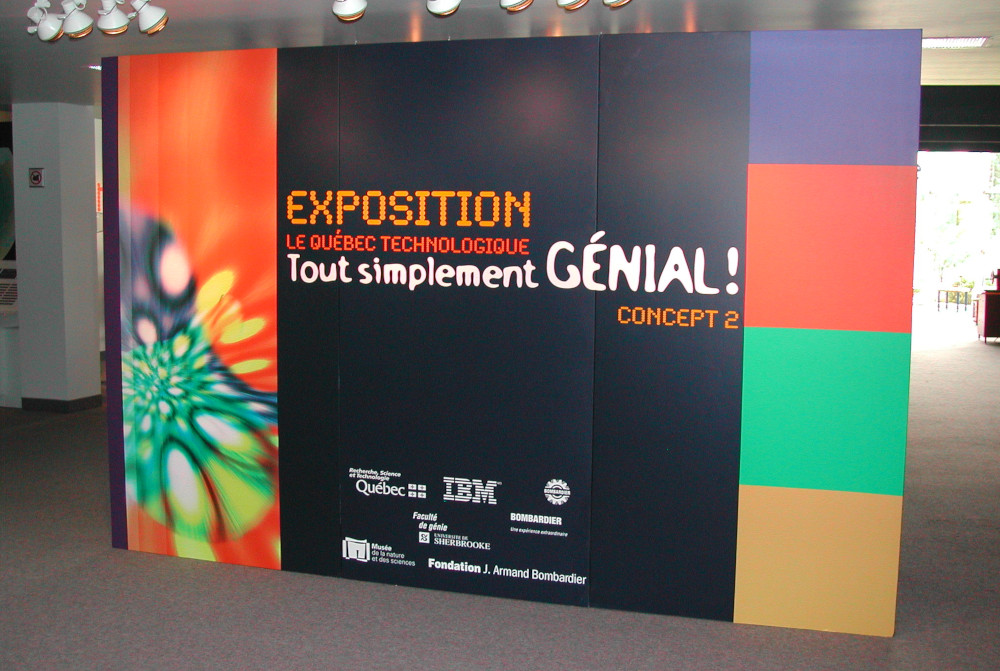
Exhibition panel, « LE QUÉBEC TECHNOLOGIQUE Tout simplement GÉNIAL! CONCEPT 2 », 2002.
It was so popular that the Museum team, with support from the MFER, brought the exhibition to Valcourt in a version tailored to the region, spotlighting technologies developed in the Eastern Townships. More than 30 innovative products designed in Québec were in the lineup. The exhibit comprised five major themes: telecommunications, multimedia, biotechnology, transportation and energy.
The exhibition also explained the most important scientific elements from an educational viewpoint, and provided secondary students with information about careers in science and technology. A zone dedicated to Bombardier Inc. showcased the technology behind the CL-415 firefighting aircraft, and the leading-edge D-Sea-Bel® noise-reducing system used on Sea-Doo® watercraft. The University of Sherbrooke was also there, with Roball, the intelligent ball-shaped robot. Joseph-Armand Bombardier’s sprocket wheel and track system was also prominently featured. One of the most popular interactive displays allowed visitors to make composite sketches of some of the most wanted criminals using the Faces software. Many police departments use the brilliant IQ Biometrix software to easily create a database.
A number of partners, including Bombardier Inc., IBM and the University of Sherbrooke’s Faculty of Engineering also helped make the event a success. The idea was to shine the light on the innovative and creative people in Québec who were at the leading edge of science and technology.
A passion for invention and entrepreneurship, 1907-1964
- February 7, 2007 to February 23, 2015
-
To celebrate Joseph-Armand Bombardier’s 100th anniversary in 2007, the Museum inaugurated a new permanent exhibition honouring the life and work of the famous inventor Joseph-Armand Bombardier. A passion for invention and entrepreneurship, 1907-1964. A complete makeover and a dynamic museum approach highlighted his principal innovations, including the famous sprocket wheel/track system. The visit was chock-full of history, inventions and tracked vehicles that traced the progress of industrial design through the decades.
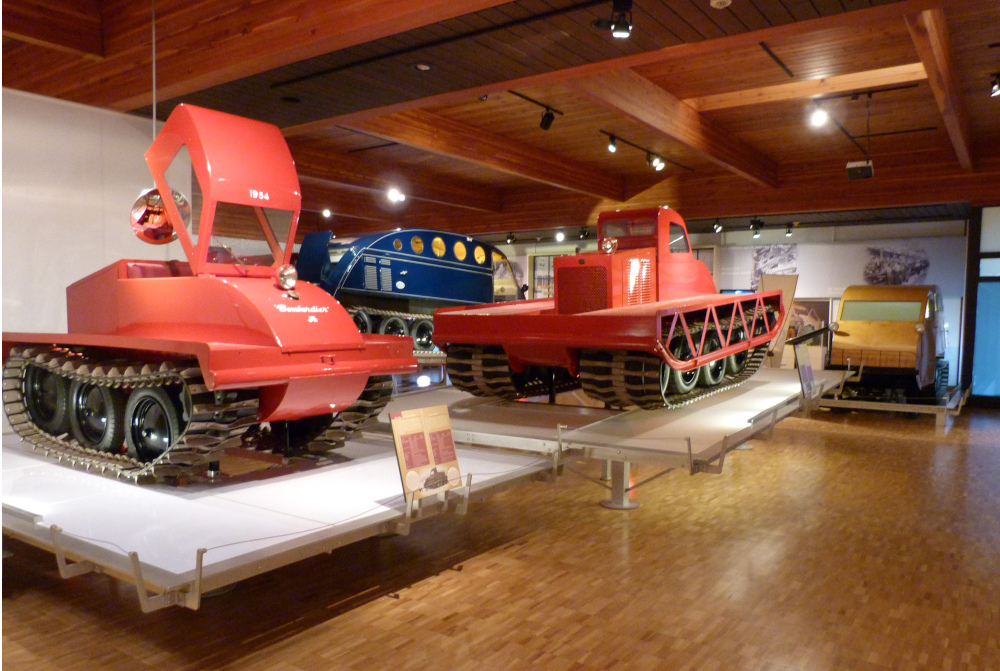
14 restored vehicles displayed on stands gave visitors a view of the different components: engine, suspension and interior design, Joseph-Armand Bombardier, a passion for invention and entrepreneurship, 1907-1964, 2007.
A new museum experience
A mural adorned with approximately 100 photographs, audiovisual archives, objects and unique documents highlighted the history and milestones of the life of Joseph-Armand Bombardier and his work in the community. Banners gave an overview of the economic, political and cultural history of 20th century Québec. Fourteen restored vehicles were displayed on stands to give visitors a view of the different components: engine, suspension and interior design. People could even climb on board a 1950 B12 CS snowmobile from the Museum collection and participate in a vox pop, leaving behind their souvenirs of the Bombardier vehicles. Testimonials from former employees and friends of the inventor underscored the value of oral history and added a special touch to the visit.
A festive inauguration!
The Museum team’s accomplishments were celebrated in the company of Yvon Vallières, Minister of Agriculture, Fisheries and Food, Minister Responsible for the Centre-du-Québec region and Member for Richmond; Lawrence Cannon, Minister of Transport, Infrastructure and Communities of Canada; Laurian Gagné, Mayor of Valcourt; Laurent Beaudoin, Chairman and CEO of Bombardier Inc., as well as friends and members of the family and the Foundation. Some 40 collectors from across Québec also came out to pay tribute to the inventor, arriving on vintage vehicles, mostly snowmobiles.
Laurent Beaudoin en/in action
- June 6 to December 21, 2008
-
“There is no business without risk.” [free translation]
Laurent Beaudoin, 2004
In 2008, Laurent Beaudoin, CEO of Bombardier Inc., retired. In his honour, the J. Armand Bombardier Museum mounted a temporary exhibition: Laurent Beaudoin en/in Action, shining the light on the businessman and his career.
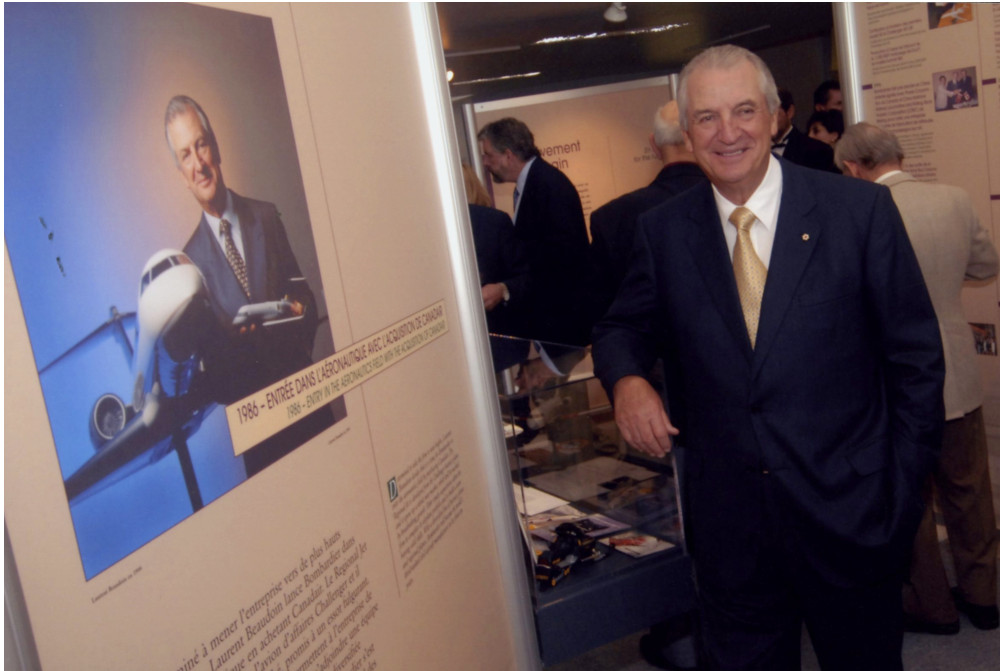
Inauguration of the exhibition « Laurent Beaudoin en/in action ». Of course, we recognize Laurent Beaudoin, 2008.
Laurent Beaudoin was celebrated through photos and objects highlighting his major achievements at Bombardier Inc. over 45 years. The Museum tour comprised eight zones. The section titled The man looked beyond the president to the man himself, displaying his office and some personal items and souvenirs. Museum-goers were invited to use a computer to send Mr. Beaudoin a personal message. The zone The man and the company provided details about his career. Four thematic sections followed, each focused on a facet of the man and a facet of the company, and then connecting the dots. The zones were titled: Sportsmanship, A vision without borders, A will to build and A responsible commitment. The section Laurent Beaudoin and Valcourt underscored Beaudoin’s strong ties with the community. The visit concluded with a complementary Conclusion from Mr. Beaudoin himself. The exhibit also noted the appointment of Pierre Beaudoin as CEO of the company, thus following in his father’s footsteps.
As visitors toured the biographical exhibition, they learned that: Laurent Beaudoin has “yellow blood” (as the saying goes); He was very much invested in the Company; He had a very strong sense of belonging to Bombardier Inc.; Without him, what would the family business have become? Would it be the world-class company it is today? We’ll never know!
50 years of Ski-Doo®
- February 21, 2009 to February 14, 2010
-
Half a century conquering winter!
In 1959, Joseph-Armand Bombardier unveiled the small vehicle of his dreams that could travel on snow: the Ski-Doo® snowmobile. The snowmobile changed significantly over time, progressing from utility vehicle to recreational vehicle. In 2009, in celebration of its 50th anniversary, the J. Armand Bombardier Museum in collaboration with BRP presented this temporary exhibition comprised of five zones.
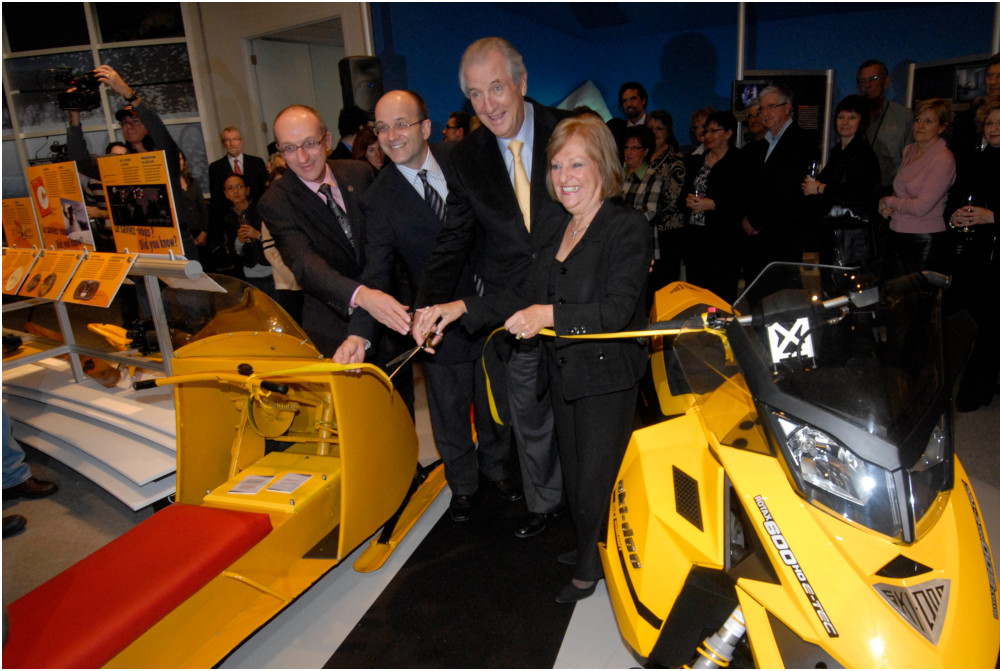
Inauguration of the « 50 years of Ski-Doo® » exhibition, we recognize Yvon Vallières, Member for Richmond, José Boisjoli, Laurent Beaudoin and Janine Bombardier, 2009.
50 years in comparison
In this zone, visitors could measure the technological advances made by comparing two vehicles: the 1960 Ski-Doo® K60, and the 2009 Summit® snowmobile, 50th anniversary edition. Improvements to the performance, ergonomics and comfort of snowmobiles were observable through changes made over time to the parts and components, including the skis, engines, tracks and suspensions.
50 years of industrialization
Here, visitors witnessed the ongoing progress and modernization that propelled Bombardier Inc. and BRP (since 2003) forward to become world leaders in snowmobile manufacturing.
50 years of performance
Since 1959, snowmobiles have evolved into sophisticated machines, making huge leaps thanks to innovative technologies. This zone spotlighted the advanced technologies that allowed Ski-Doo® snowmobiles to shine in the racing circuits, both on and off-trail.
50 years of research and design
This zone showed visitors how BRP tackled the challenges of safety and respect for the environment. The tradition of innovation is reflected in the evolution of the vehicles, as well as the clothing and accessories.
50 years of marketing
This zone presented an overview of the company’s marketing activities. When production of the Ski-Doo® was launched in 1959, the company went all out in respect to marketing and customer service: sales soared. Snowmobiling activities diversified with several different market segments: trail and touring, mountain, snocross, hill climbing, sport-utility, etc. BRP’s sales grew steadily on world markets, thanks to an expanding network of dealers.
The exhibition was popular among the general public and snowmobile enthusiasts alike. It allowed the community to relive the past 50 years and the milestones of the Ski-Doo® brand.
The ingenuity of J. Armand Bombardier…
- March 26, 2010 to January 30, 2011
-
The ingenuity of J. Armand Bombardier…
The sprocket wheel/track systemThe sprocket wheel/track drive system, invented in 1935 by Joseph-Armand Bombardier, revolutionized the world of transport. In celebration of the 75th anniversary of this important invention, the J. Armand Bombardier Museum presented this exhibition comprised of 3 zones: the advent, the birth and the development of the ingenious mechanism that completely changed the future of transportation over snow and difficult terrain. The exhibition featured 5 vehicles from the Museum.
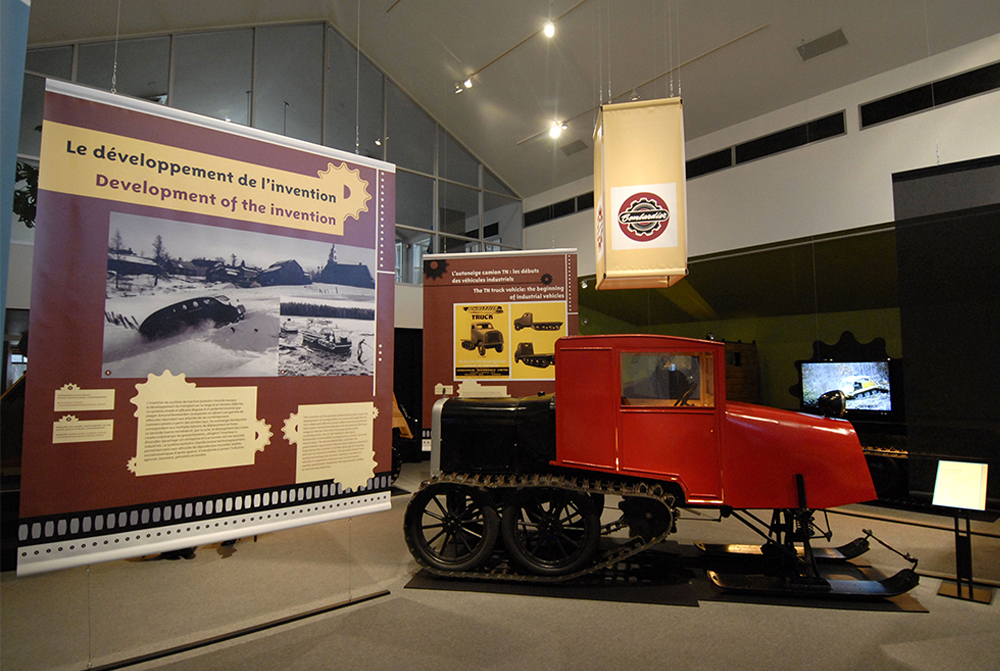
The 1935 vehicle on display at “The ingenuity of J. Armand Bombardier… The sprocket wheel/track system” exhibition, 2011.
The advent of the invention
A number of people developed vehicles equipped with rigid or flexible track systems for transport over snow or difficult terrain. However, only a few of those vehicles were introduced on the market. The first zone displayed precursors to tracked vehicles dating to the first quarter of the 20th century, including Joseph-Armand Bombardier’s 1922 vehicle. An interactive display helped visitors gain a better understanding of the track system and its use of buoyancy.
An invention is born
This section outlined the various steps from 1927 to 1935, which lead to the invention of the sprocket wheel/track system. Visitors followed Joseph-Armand Bombardier and his progression of prototypes, as he worked on developing a vehicle that could move efficiently and reliably over snow. An interactive educational display shed light on the major challenges the inventor came up against.
Development of the invention
The final zone presented the developments and applications of the tracked vehicles Joseph-Armand Bombardier designed, starting in 1937. This sprocket wheel/track system was simple, efficient and had enormous potential, which the inventor capitalized on to produce a line of vehicles tailored to customer needs. Dedicated to the general public, the exhibition invited people to travel back in time by climbing aboard an emblematic 1950 B12 CS snowmobile, one of the vehicles featured in the Museum’s collection.
Expedition: The Arctic
- February 1 to April 7, 2013
-
The Arctic is a hostile territory home to mysteries unveiled over time. From 1913 to 1918, a brave group set off to explore the waters of the Polar Circle, with funding from the Canadian government. The year 2013 marked the 100th anniversary of this epic adventure. A host of activities was organized to celebrate the expedition, including this temporary exhibition that tracked the movements of the expedition party.
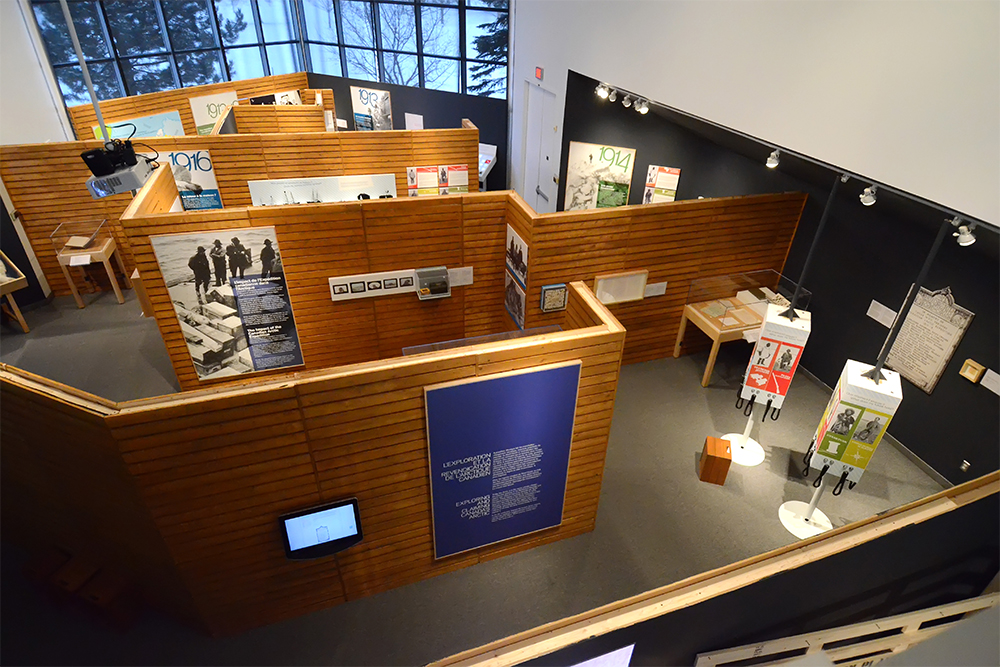
A view from above, “Expedition: The Arctic”, 2013.
The J. Armand Bombardier Museum had the opportunity to host the exhibition during the centennial year. Designed by the Canadian Museum of Civilization in collaboration with the Canadian Museum of Nature, the exhibition immersed visitors in the history of Canada. The expedition was retold through some one hundred artifacts, many on public display for the first time. Visitors admired the artifacts, which included work tools, clothing made by the Inuit, as well as fossils of plants, mammals and birds. The exhibition also underscored the impacts of the expedition, such as the discovery of new territories, greater understanding of the Inuit culture, and the expansion and affirmation of Canada’s sovereignty in the Arctic.
The exhibition was geared toward children, who were invited to role play throughout the tour. As they set out, Museum-goers could choose one of the 16 “Explorer Cards” and experience the expedition through the lens of the various expedition participants, including clothing makers, scientists, sailors and explorers.
With a focus on the North and the 1913 expedition, the exhibition included a section on the Plaisted Polar Expedition, the first group to reach the North Pole over land by motorized vehicles. It featured one of the Ski-Doo® Olympique snowmobiles that made the trek in 1967, as well as iconic documents related to the Plaisted Polar Expedition. The vehicle on display is still part of the Museum collection! In fact, you can catch a glimpse of it when you take the Conquest through Innovation tour of the Museum reserve.


